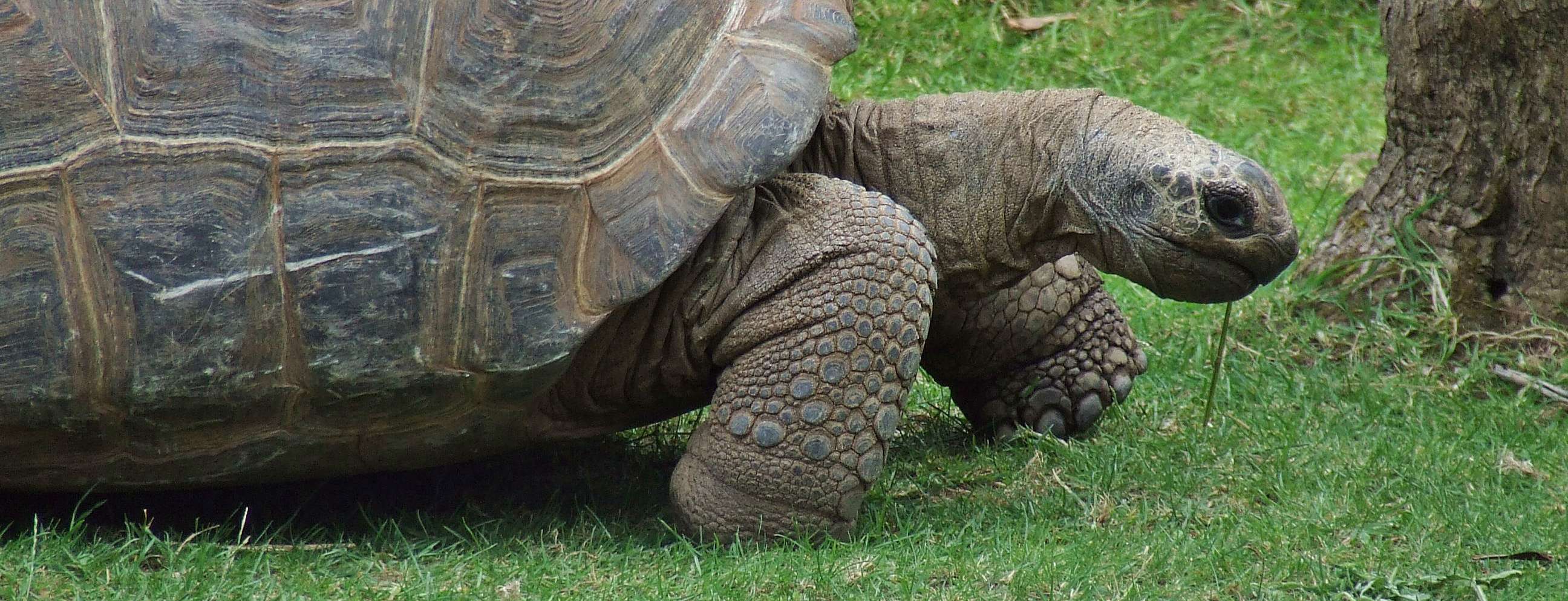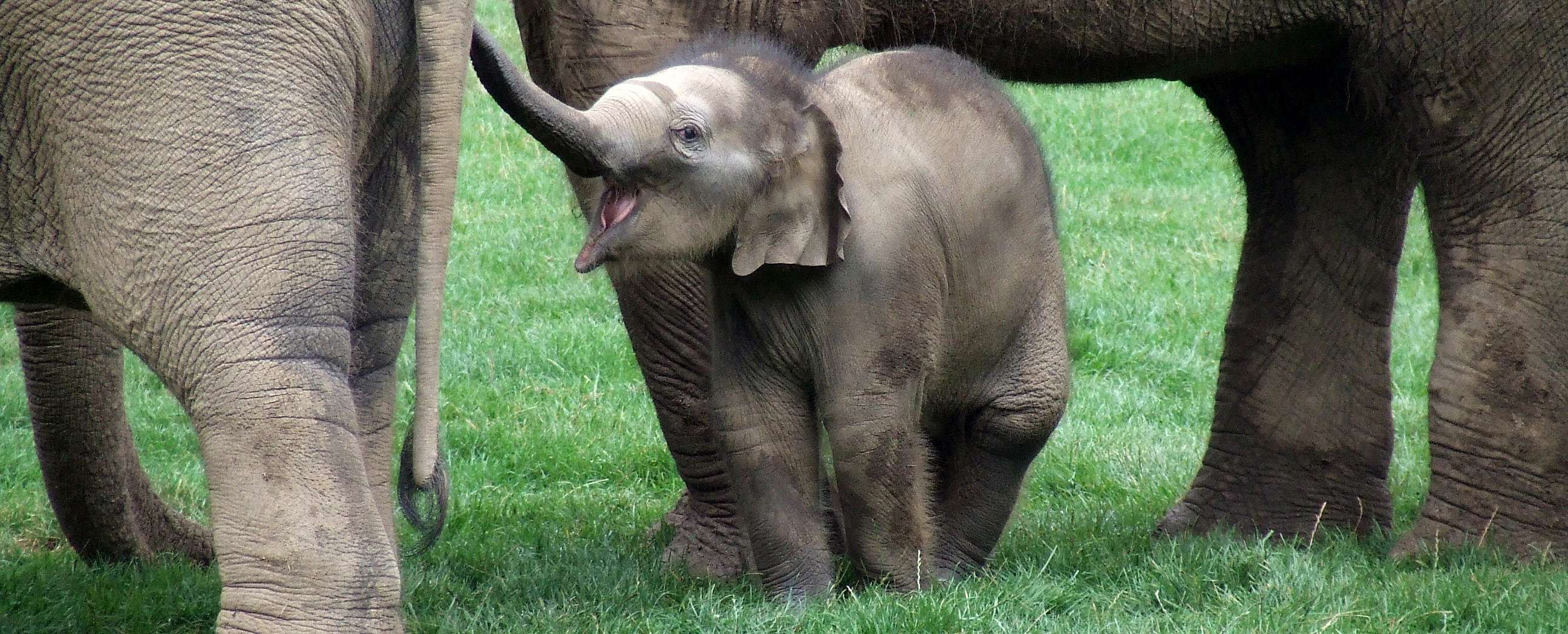Európa állatkertjei
ZOOlogical Gardens of EuROPE
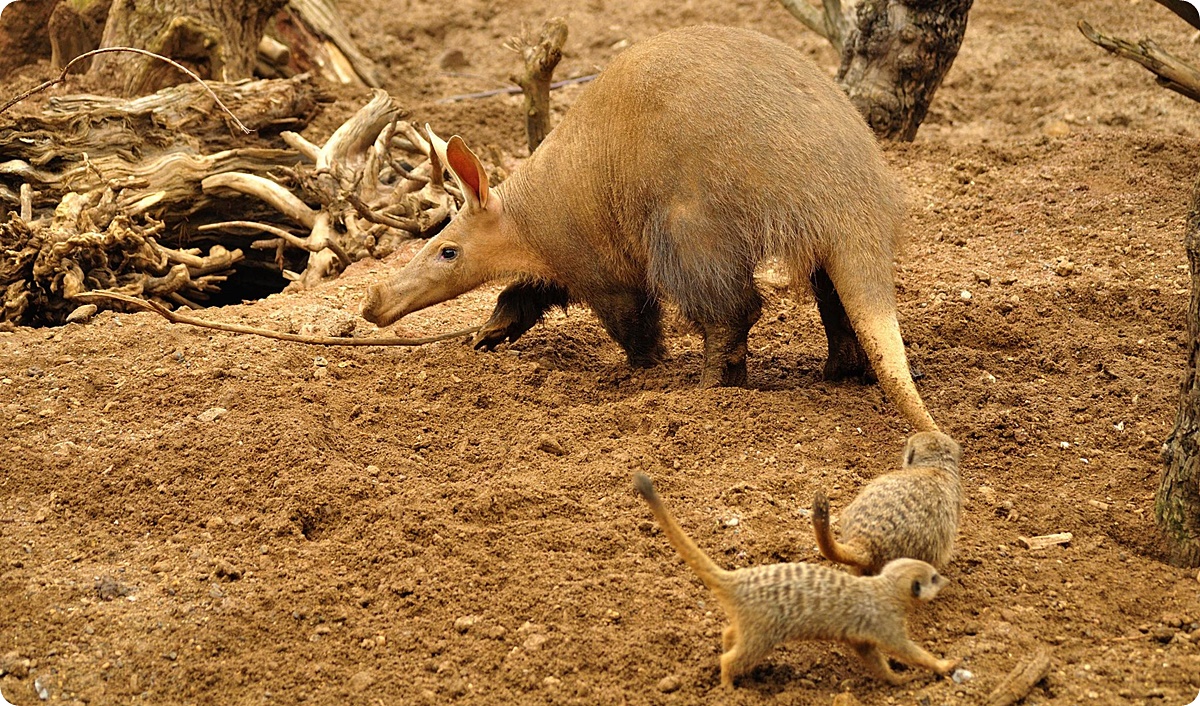
Mixed-species exhibits with zoo-housed Aardvarks (Orycteropodidae)
Written by KRISZTIÁN SVÁBIK
Biologist-Ecologist
Team Leader, Toni’s Zoo, Rothenburg, Lucerne, Switzerland
former Deputy Curator, Budapest Zoo and Botanical Garden, Hungary
Email: svabik.krisztian@gmail.com
12th November 2022
Cover photo © Richard Southwell
“It is my pleasure to recommend the mixed-species document(s) created by Krisztián Svábik. These are informative and great reference documents if you are looking for examples of proven mixed-species exhibits. A great source of knowledge for zoo directors, curators and zoo designers.”
by Willeke Huizinga,
Owner of Wildlife’s Welfare and former Curator of Bush, Desert & Mangrove in Royal Burgers' Zoo in Arnhem and former European Studbook (ESB) keeper of the Aardvark
INTRODUCTION
Mixed-species exhibits with different mammals in the last few decades became a major trend. The success of a mixed-species exhibit depends on how we can take general animal husbandry criteria into account in more complex ways in comparison with a single-species exhibit. Those general rules that are important in animal exhibitry are still valid to a greater extent when presenting a multi-species captive environment. As many articles and other publications deal with the subject of general advantages and disadvantages of the mixed-species exhibits, instead of this, here I will assemble a detailed list of mixed exhibits involving the only one living species of family Orycteropodidae, the Aardvark (Orycteropus afer). The main aim of these documents is to summarize data and experiences about this exhibitry type with the hope that these manuals will be a useful supplement for the husbandry guidelines of this unique species. Furthermore the study partly focuses on negative experiences in order to improve exhibit management criteria and trying to avoid combinations that have not been proved as successful.
The most important aspects of a successful mixed exhibit are the purposeful use of space and enclosure furnishings, the appropriate feeding techniques, decision-making of which species we want to breed and the right choice of species and individuals.
Use of space and enclosure furnishings
Generally speaking, one of the most critical factors is the size of the area: the larger the enclosure, the fewer the problems. Expanding the size of the whole captive habitat we can greatly increase the chances that the specimens of the different species are able to get out of each other’s way. Although this quantitative factor is also important, the quality of the given enclosure is much more crucial, since these agents can ensure the stress-free socialization of the combined species. It is extremely important to provide a secure outdoor and indoor space for the subdominant specimens whether belonging to the same species or not. The outdoor exhibit should be well-structured with many kinds of enclosure furnishing elements like small mounds, logs, rock formations and heavily planted areas so that the animals can get out of visual contact with others sharing the same enclosure and provide several escape routes in case of an aggressive contact between the different species. The best option is if the subdominant species have their own areas both outdoors and indoors. In many of the cases of mixed exhibits with Aardvarks aggression towards the other species was not a common problem, although due their relatively big body weight in comparison to the associated species they can be dangerous for them as examples show that in cohabitations with Spring Hares.
Feeding
In terms of the daily routine tasks using the appropriate feeding techniques is one of the key factors of success. The experiences show that in several cases the associated species can be easily competitors of each other in reference to nutrition. As a general rule, therefore it is necessary to feed the smaller species separately or provide as many feeding stations as possible throughout the whole enclosure and keep the competition to a minimum level, because most of the injuries and fatal accidents are the results of food-related aggression. Feeding the different species separately is a participating factor to manage the mixed-species exhibit successfully, but on the other hand this makes it difficult to apply certain food-related environmental enrichment methods in comparison with a single-species enclosure. Meerkat aggression towards the Aardvark was observed over food and space but with time these conflicts resolved. Until this time fatal accidents were not reported in reference to Aardvark associated with other species.
Breeding
One of the most important questions is to decide whether we would like to breed the species involved in a multi-species exhibit, or which species we want to breed. The general practice of mixed-species exhibitry shows that the presence of large animals means potential danger for the other species when they are dominant in the given coexistence. Providing the abovementioned own areas or total separation can be the solution during the time of rearing the young. Furthermore, the behavioural changes of the adult animals during the breeding season must also be borne in mind which may easily lead to fatal injuries. Therefore, it is really important to emphasize the possibility of proper separation. Generally speaking it seems to be true that the proper management of breeding in a mixed-species enclosure is more difficult – or sometimes impossible – than in a single-species exhibit. As a result, there is no aim to breed (all) the animals in this type of exhibitry in many cases, so sterilisation and single-sex grouping are also applied techniques in managing. If any of the species has an important breeding programme like SSP or EEP, it is worth to look over and analyse all the mentioned disadvantages before putting the given animals into a mixed enclosure. On the whole it can be said that within mixed-species exhibits with Aardvark breeding of most of the different species is successful or relatively less problematic.
Choice of species and individuals
According to the criteria of species selection, most of the known examples show that zoos exhibit animals together from the same geographic region for educational purposes. In the case of combining species that occupy similar ecological niches in nature the level of competition can be very high, therefore a large difference in body size between the combined species may be part of the solution. Choosing animals with different lifestyles – for example terrestrial-arboreal or diurnal-nocturnal – might be a good option as well. Although considering the theoretical approaches of the appropriate selection of species are also very important, we have to take into account that the success of the combination depends mostly on the individual level, simply because of the diverse individual characteristics of the animals in terms of behaviour. Correct introduction of the different species is a very sensitive issue which depends principally on the method of socialization and age of the animals. Introducing the smaller and subdominant species to the exhibit can be efficient due to exploring the whole area. During socialization the principle of gradience should be followed, so visual and olfactory stimuli have to be the first before the possibility of physical contact of the animals. In general younger animals can be combined easier, but the experiences have shown us that many adult Aardvark specimens have successfully been mixed with several other taxa.
List of mixed-species exhibits involving Aardvark
This document purposefully focuses on creating a list of mixed-species exhibits with family Orycteropodidae, for further and detailed information it is worth contacting the institutions mentioned further on. Only a short summary of the general experiences is given at the end of the document. Many of the listed coexistences are still ongoing at present, but many of them are not anymore.
In the list below you can see that the only one species of order Tubulidentata have been kept in mixed exhibits in captivity:
Aardvark, Orycteropodidae
Aardvark, Orycteropus afer PALLAS, 1766
Commensalism, as a didactic concept in mixed-species exhibitry
In the introduction of mixed-species documents dealing with Mongooses (Herpestidae) and Hippopotamuses (Hippopotamidae) mutualism, as a possible didactic concept in creation of multi-species enclosure was mentioned. Now, in case of mixed-species exhibits with Aardvark (Orycteropodidae) it is worth emphasizing the commensalism as a potential didactic concept.
The Aardvark is considered an important ecosystem engineer (see below) as well as an African keystone species (CILLIERS 2002) because it actively modifies its environment via its extensive digging activity in three ways, namely (a) exposure of food sources for commensal feeders (TAYLOR 2013, TAYLOR & SKINNER 2000 and 2001), (b) construction of burrows (WHITTINGTON-JONES et al. 2011) and (c) promoting plant germination (DEAN & MILTON 1991). The aardvark’s presence in an ecosystem is thus beneficial for many other animal and plant species (WEYER 2018).
In this document these commensal relationships will be observed from the associative feeding and the use of burrows point of view.
Aardvarks are myrmecophagous, they eat ants and termites. The feeding activities of Aardvarks may be seasonally important to other myrmecophagous species and commensal associations have been reported. In South Africa, Aardwolves (Proteles cristata) feed exclusively on the termite Trinervitermes trinervoides, but they can only do when the insects are active on the surface as the Aardwolves are unable to break open the termite mound to reach the termites inside. During winter this species of termites rarely forage above ground making it hard for the Aardwolves to find enough food. Aardvarks break open termitaria to feed and when they stop eating there are many insects left behind. Aardwolves utilize this resource by following Aardvarks around and feeding from the opened termite mounds after the Aardvark moves away. When Aardvarks become active during the day, some bird species hang around and feed on ants from the opened mounds (TAYLOR & SKINNER 2000, TAYLOR 2011). During the winters of 1997 and 1998, two Aardvarks were followed regularly in the late afternoon, at which times Southern Anteater-chats (Myrmecocichla formicivore) were often observed flying around in close proximity to the Aardvarks or perching on nearby bushes and the mounds of Trinervitermes trinervoides. The birds normally waited until the Aardvark had moved partially away from the food excavation before flying down from their perches to pick up termites which were invariably left on the surface. Although the feeding behaviour of the Anteater-chats was never quantified, the presence of birds and commensal feeding was recorded when it occurred. The association, from which only the birds benefited, was only observed to take place in the winter months, at times when the Aardvarks were active in the daytime (TAYLOR & SKINNER 2001). Thus, Aardvark facilitates access to insect prey for various opportunistic feeders. Their feeding pits serve as important food supplementation for opportunists that would otherwise not be able to reach deeper soil levels where ants and termites are abundant, especially during winter, when the surface-foraging activity of ants is reduced and Aardvarks often forage during daylight hours (CILLIERS 2002, TAYLOR 2013). Animals that exploit Aardvark feeding sites include Bat-eared Foxes (Otocyon megalotis) and Southern Yellow-billed Hornbills (Tockus leucomelas) (TAYLOR 2013, TAYLOR & SKINNER 2000 and 2001) as well, beside the abovementioned Aardwolves and Southern Anteater-chats (WEYER 2018). Similar associations are known with baboons (Papio sp.) as well (TAYLOR 2011).
In zoo environment mixed-species exhibit with Aardvark and Aardwolf has formerly been created in Zoo Frankfurt and a coexistence of Aardvark and Bat-eared Fox were established in Bioparc Valéncia and Bioparc de Doué-la-Fontaine.
Certain burrowing mammals such as Aardvarks create complex underground structures which are utilised by other species seeking refuge from predators and harsh environmental conditions (REICHMAN & SMITH 1990, KINLAW 1999). The animals which create these extensive underground structures can be viewed as “ecosystem engineers” in accordance with the definition of JONES et al. (1994) who proposed that “ecosystem engineers are organisms that directly or indirectly modulate the availability of resources (other than themselves) to other species, by causing physical state changes in biotic or abiotic materials. In doing so they modify, maintain and/or create habitats” (WHITTINGTON-JONES 2006). Burrowing activities are an important form of natural disturbance in many ecosystems and burrowing animals are often considered to be ecosystem engineers (BRAGG et al. 2005, DESBIEZ & KLUYBER 2013, GÁLVEZ-BRAVO et al. 2009, HAUSSMANN et al. 2018). Aardvarks fulfil the criteria of a significant ecosystem engineer and can be regarded as keystone species as their presence in arid and semi-arid environments is likely to be critical to the survival of other individual organisms and species, particularly when alternative burrowing animals are either absent or restricted in their activities (WHITTINGTON-JONES 2006).
The animals that utilize burrows can be grouped into three main categories: primary excavators, secondary modifiers and burrow occupants. Digging is an important aspect in the lives of primary excavators and they possess the ability to dig large and complex burrows that can have a significant ecological impact (KINLAW 1999). Although the energetic cost of creating a relatively simple hole may not be particularly high, with certain animals such as armadillos digging new shelters sometimes on a nightly basis, the cost increases the larger and more complex the burrows become (REICHMAN & SMITH 1990, WOOLNOUGH & STEELE 2001). Even the most remarkable example of a primary excavator, the Aardvark, may not dig a new burrow every night but will rather return to an old tunnel or modify a hole abandoned by another individual (SKINNER & SMITHERS 1990). Secondary modifiers are restricted to digging their own burrows in softer soils and may live in and alter burrows created by primary excavators. Cape Porcupines (Hystrix africaeaustralis), Bat-eared Foxes (Otocyon megalotis) and warthogs (Phacochoerus sp.) are a few examples of vertebrates recorded modifying and inhabiting Aardvark burrows (CUMMING 1970, SKINNER & SMITHERS 1990). With reference to warthogs it is worth mentioning that the abundance of Common Warthogs (Phacochoerus africanus) is probably linked to the availability of Aardvark holes, as the warthogs need deep burrows from protection from predators and as well as from fluctuations in temperature and humidity (MEIJAARD et al. 2011). The third category of animals, burrow occupants, save time and energy by living in or using the burrows of other animals without making any alterations to them (KINLAW 1999). Many birds, reptiles – such as the Southern African Rock Python (Python natalensis) – amphibians and invertebrates are members of this group (BRANCH 1993, KINLAW 1999). Burrow occupants which regularly inhabit a burrow of a particular excavator or modifier are known as commensal organisms. These species may be further divided into obligate commensals, which are only found associated with that burrow type, and non-obligate commensals, which will use whatever refuge is available (KINLAW 1999). Information regarding vertebrate and invertebrate commensals inhabiting Aardvark burrows does exist but is usually embedded in the literature pertaining to the individual commensal species (WHITTINGTON-JONES 2006).
Aardvarks dig burrows and during daylight hours they remain in shelters to sleep. These burrows act as shelters against extreme temperatures and provide protection against different predators. Most of the burrows have only one entrance, although in many cases multiple entrances have been recorded and these holes can be more than three metres deep and ten metres long. Worth mentioning that Aardvarks only use them for short periods, e.g. just for 1-20 days. Digging new tunnels is uncommon, instead Aardvarks often renovate older ones (TAYLOR 2011).
Arid and semi-arid environments are characterized by extreme fluctuations in temperature and low rainfall, which present significant challenges to the animals inhabiting these areas. However, the presence of Aardvark burrows may allow animals to avoid climatic extremes and predators and may act as valuable foraging sites.
Soil has insulating properties which results in the moderate below-ground environment of burrows providing suitable shelter in both hot summers and cold winters for a variety of species (REICHMAN & SMITH 1990, FINLAYSON et al. 2005). Aardvark burrows show ameliorated temperature and moisture regimes compared to outside soils (WHITTINGTON-JONES et al. 2011) and therefore have the potential to provide thermal and moisture refugia to both plant (WIEGAND et al.1997) and animal species (HAUSSMANN et al. 2018, WHITTINGTON-JONES et al. 2011). WHITTINGTON-JONES et al. (2011) assessed the microhabitat conditions – such as maximum and minimum temperature and relative humidity – of Aardvark burrows in relation to paired non-burrow areas at three sites in South Africa. They also described the extent to which they are used as resources by other vertebrates. Maximum temperatures were significantly lower and minimum temperatures and relative humidity values were significantly higher inside the burrows than outside.
Aardvarks are important in their ecosystem because their unoccupied burrows are used extensively by a variety of other animals for shelter. These include hyenas, warthogs, squirrels, hedgehogs, mongooses, and bats, as well as birds and reptiles (KINGDON 1997). 27 vertebrate species – 21 mammals, two birds, three reptiles and one amphibian – were recorded making use of the burrows and it is likely that these species accrue benefits (e.g. a buffered microclimate) from burrow use. However, this sampling was biased towards mammals and nocturnal species (WHITTINGTON-JONES et al. 2011). One earlier study – WHITTINGTON-JONES (2006) – revealed a total of 39 nocturnal and diurnal species which include 25 mammal, seven bird, six reptile and one amphibian species utilising Aardvark burrow. These are the followings: South African Ground Squirrel (Xerus inauris), Natal Multimammate Mouse (Mastomys natalensis), Four-striped Grass Mouse (Rhabdomys pumilio), South African Pouched Mouse (Saccostomus campestris), African Pygmy Mouse (Mus minutoides), Desert Pygmy Mouse (Mus indutus), Cape Short-eared Gerbil (Desmodillus auricularis), Hairy-footed Gerbil (Gerbillurus paeba), Highveld Gerbil (Tatera brantsii), Bushveld Gerbil (Tatera leucogaster), White-tailed Rat (Mystromys albicaudatus), Namaqua Rock Rat (Aethomys namaquensis), Brants’s Whistling Rat (Parotomys brantsii), Cape Porcupine (Hystrix africaeaustralis), Cape Scrub Hare (Lepus saxatilis), Forest Shrew (Myosorex varius), Afro-Asiatic Wildcat (Felis lybica), Aardwolf (Proteles cristata), Yellow Mongoose (Cynictis penicillate), Black-backed Jackal (Canis mesomelas), Bat-eared Fox (Otocyon megalotis), Cape Fox (Vulpes chama), Honey Badger (Mellivora capensis), Desert Warthog (Phacochoerus aethiopicus), Steenbok (Raphicerus campestris), Grey-headed Kingfisher (Halcyon leucocephala), African Pygmy-kingfisher (Ispidina picta), Little Bee-eater (Merops pusillus), Rufous-chested Swallow (Cecropis semirufa), Pearl-breasted Swallow (Hirundo dimidiata), Southern Anteater-chat (Myrmecocichla formicivore), Mocking Cliff-chat (Thamnolaea cinnamomeiventris), Cape Skink (Trachylepis capensis), Ground Agama (Agama aculeate), White-throated Monitor (Varanus albigularis), Southern African Rock Python (Python natalensis), Puff Adder (Bitis arietans), Cape Cobra (Naja nivea), Karoo Toad (Vandijkophrynus gariepensis). Furthermore, WHITTINGTON-JONES (2006) also provides two additional references to which mammal and bird species use Aardvark holes. SKINNER & SMITHERS (1990) lists the following 21 mammal species using Aardvark burrows: South African Pouched Mouse (Saccostomus campestris), Cape Porcupine (Hystrix africaeaustralis), Cape Hare (Lepus capensis), Hairy Slit-faced Bat (Nycteris hispida), Hildebrandt’s Horseshoe Bat (Rhinolophus hildebrandtii), Temminck's Pangolin (Smutsia temminckii), Leopard (Panthera pardus), Caracal (Caracal caracal), Afro-Asiatic Wildcat (Felis lybica), Black-footed Cat (Felis nigripes), Common Genet (Genetta genetta), Aardwolf (Proteles cristata), Brown Hyena (Parahyaena brunnea), Spotted Hyena (Crocuta Crocuta), Common Slender Mongoose (Galerella sanguinea), Banded Mongoose (Mungos mungo), Side-striped Jackal (Canis adustus), Black-backed Jackal (Canis mesomelas), African Wild Dog (Lycaon pictus), Bat-eared Fox (Otocyon megalotis), Desert Warthog (Phacochoerus aethiopicus). HOCKEY et al. 2005 reported the following 16 bird species using Aardvark burrows: South African Shelduck (Tadorna cana), Egyptian Goose (Alopochen aegyptiaca), Spur-winged Goose (Plectropterus gambensis), Malachite Kingfisher (Corythornis cristatus), Grey-headed Kingfisher (Halcyon leucocephala), Brown-hooded Kingfisher (Halcyon albiventris), African Pygmy Kingfisher (Ispidina picta), Böhm’s Bee-eater (Merops boehmi), Swallow-tailed Bee-eater (Merops hirundineus), Little Bee-eater (Merops pusillus), Rufous-chested Swallow (Cecropis semirufa), Blue Swallow (Hirundo atrocaerulea), Pearl-breasted Swallow (Hirundo dimidiata), Banded Martin (Neophedina cincta), Black Saw-wing (Psalidoprocne pristoptera), Southern Anteater-chat (Myrmecocichla formicivore).
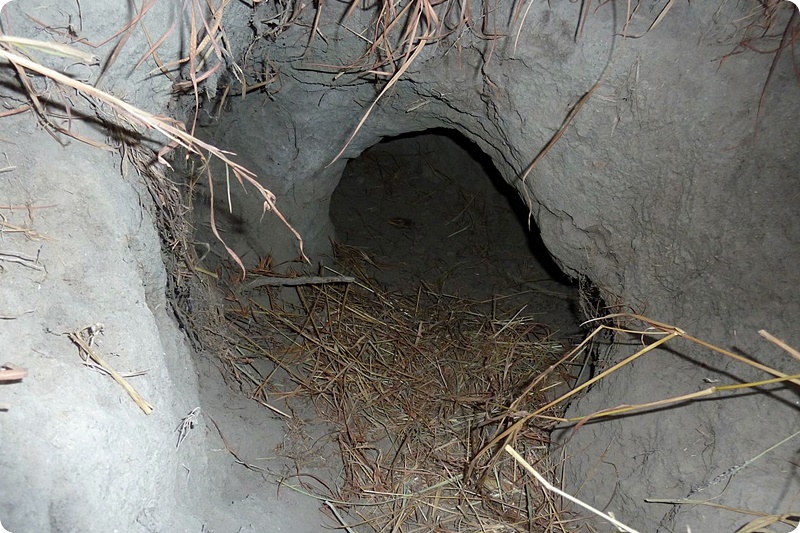
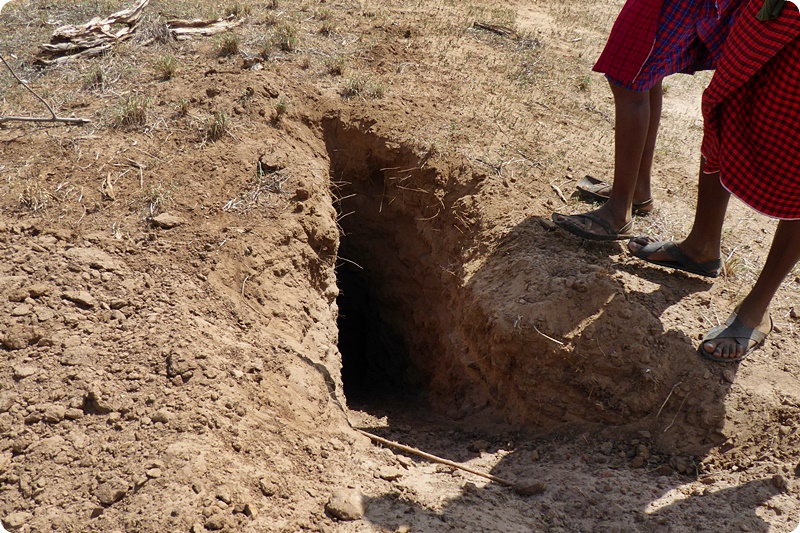
Entrances of Aardvark burrows in KwaZulu-Natal in South Africa and Amboseli National Park in Kenya
Photos © Wikimedia Commons and Regina Hart
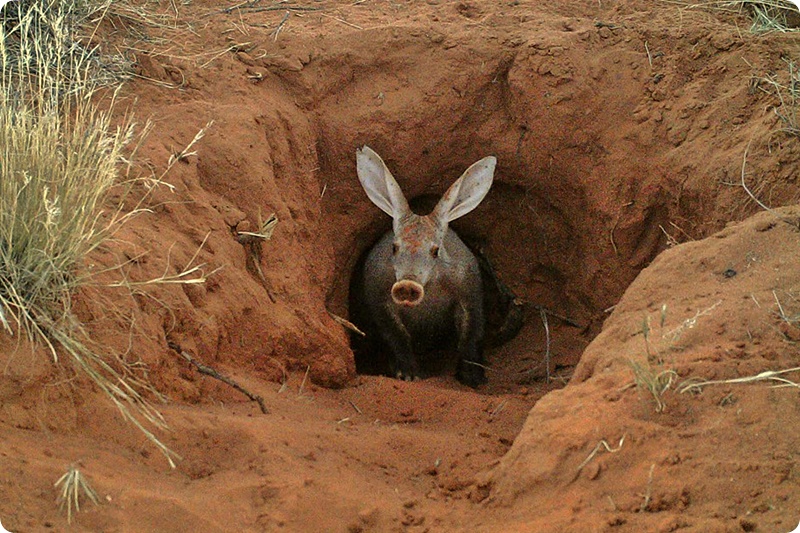
Aardvark emerges from its burrow in SanWild Wildlife Sanctuary in South Africa
Photo © Louise Joubert
In zoo environment with reference to commensal species which utilizing Aardvark burrows the most perfect example is a smaller section of the Savannah exhibit in Bioparc Valéncia, where the naturalistic replicas of huge termite mounds of a South African termite species, Macrotermes natalensis allow a large community of different species to make their home. These artificial termite mounds at the zoo are shelters to a large number of animals that either live underground or use them as burrows or as a source of food. In Aardvark Burrow exhibit visitors can see many nocturnal animals in neighbouring enclosures. Previously, beside the Aardvark some of the species in this area were included Cairo Spiny Mouse (Acomys cahirinus), Gambian Rat (Cricetomys gambianus), Cape Porcupine (Hystrix africaeaustralis), Common Dwarf Mongoose (Helogale parvula), Bat-eared Fox (Otocyon megalotis) and Nile Monitor (Varanus niloticus). Currently Naked Mole Rat (Heterocephalus glaber), Ball Python (Python regius) and Central African Rock Python (Python sebae) are also exhibited in this area of the zoo. In neighbouring areas enclosures for Spotted Hyenas (Crocuta Crocuta) and Common Warthogs (Phacochoerus africanus) are also created. Many of these species or one of their closely related taxa were also mentioned beforehand in reference to species that use Aardvark burrows in nature. Beforehand Aardvarks shared their exhibit with Bat-eared Foxes and were rotated with warthogs in their outdoor enclosure in Bioparc Valéncia. Worth mentioning that Zoo Praha also rotated their Aardvarks with Red River Hogs (Potamochoerus porcus) in one of the outdoor enclosures adjoining the African House.
In Colchester Zoo – the exhibit also called Aardvark Burrow – was previously written out for visitors that disused Aardvark holes are used for refuge by many different animals so they are vital keystone species in the savannah ecosystem. Currently the Aardvarks here are sharing their enclosure with Rock Hyraxes (Procavia capensis).
In summary, according to the much-discussed commensal relationships – both from the associative feeding and the use of burrows point of view – many abovementioned species – of course with the exception of large and medium-sized carnivores and hoofed mammals – could potentially be considered when creating a mixed exhibit with Aardvark. However, referring to the use of burrows it should also be taken into account that species mentioned above utilize abandoned Aardvark burrows, therefore direct contact between the species or close proximity to each other is not typical. So, a common use or a willingness to use the same underground hole or resting-place at the same time in captivity may result in some degree of aggression or stress. It has been reported that mild stress was also present between the species due to the common use of the underground holes when the Aardwolves went into the Aardvarks’ burrow in Zoo Frankfurt, see details later on the summary of experience. Furthermore, it is also interesting to point out that three species – Aardwolf, Bat-eared Fox and Southern Anteater-chat – were also mentioned in both themes of commensal feeding and utilizing abandoned Aardvark holes as well.
Entrance of the Aardvark Burrow exhibit, 2011
Bioparc Valéncia, Valencia, Spain
Photo © Ben Gilbert
Aardvark (Orycteropus afer) in Aardvark Burrow exhibit, 2011
Bioparc Valéncia, Valencia, Spain
Photo © Ben Gilbert
Aardvarks (Orycteropus afer) and Common Warthogs (Phacochoerus africanus) were rotated on this outdoor enclosure adjoining Aardvark Burrow exhibit, 2011
Bioparc Valéncia, Valencia, Spain
Photo © Ben Gilbert
Finally, it is also worth mentioning that Aardvark has the potential to directly affect plant species composition by facilitating seed dispersal (HAUSSMANN et al. 2018, MILTON & DEAN 2001).
Although it is partly off to our main topic, it is definitely worth mentioning an interesting relationship between the Aardvark and a plant species. Aardvarks allegedly play a role in the seed dispersal of the Aardvark Cucumber (Cucumis humifructus), a rare geocarpic plant with a limited distribution (MEEUSE 1958, KINGDON et al. 2013). It is suggested that the Aardvark digs for and consumes the fruit of the Aardvark Cucumber – which grows underground – for its moisture content. The seeds are then dispersed through droppings and as such the plant is often found growing at the entrances of refuge digs, where droppings are regularly deposited (MEEUSE 1958). However, an Aardvark consuming the fruit of this plant has never been directly observed and it is suggested that they lack the mouth parts required to break open the tough rind of the fruit. Furthermore, the water requirements of the Aardvark are satisfied through the consumption of ants and termites (KINGDON et al. 2013) and through drinking from rivers, dams and even ephemeral puddles (KERLEY & TOMPKINS 2017, MARTIN 2017). According to TAYLOR (2011) reports of eating this geocarpic fruit of this cucumber need to be confirmed as well. The seeds of this plant have been found in Aardvark feces and the plant itself found growing out of feces at burrow entrances. It is thought that the Aardvark is the only animal capable of digging the fruit out of the ground and, therefore, the sole means of perpetuation of the species. This plant is not found outside the geographical range of the Aardvark. As a result, a symbiotic relationship has been proposed whereby the Aardvark benefits from digging up the fruit for its moisture, while the cucumber benefits because its seeds get ingested and then conveniently planted in manure. An alternative explanation for the occurrence of seeds in Aardvark feces is that granivorous ants collect the seeds, which then get eaten coincidentally when the Aardvark eats the ants. Aardvark feces contain many other types of seeds that are ingested when feeding on seed-harvesting ant species. Furthermore, Aardvarks are able to obtain most, if not all of the water requirements from their food, they just rarely drink.
LIST OF SPECIES COMBINATIONS - ORYCTEROPODIDAE
The list shows examples of species combinations with Aardvark combined with the taxa below
Aardvark, Orycteropus afer (Photo © Krisztián Svábik)
Bush Hyrax, Heterohyrax brucei
Rock Hyrax, Procavia capensis
Hoffmann's Two-toed Sloth, Choloepus hoffmanni
Grey Mouse Lemur, Microcebus murinus
Mongoose Lemur, Eulemur mongoz
West African Potto, Perodicticus potto
Northern Lesser Galago, Galago senegalensis
Thick-tailed Greater Galago, Otolemur crassicaudatus
Garnett's Greater Galago, Otolemur garnettii
Guenon, Cercopithecus sp.
Diana Monkey, Cercopithecus diana
South African Ground Squirrel, Xerus inauris
Spring Hare, Pedetes capensis
African Brush-tailed Porcupine, Atherurus africanus
Cape Porcupine, Hystrix africaeaustralis
Brazilian Guinea Pig, Cavia aperea
Indian Flying Fox, Pteropus giganteus
Rodrigues Flying Fox, Pteropus rodricensis
Egyptian Fruit Bat, Rousettus aegyptiacus
Aardwolf, Proteles cristata
Meerkat, Suricata suricatta
Common Dwarf Mongoose, Helogale parvula
Common Cusimanse, Crossarchus obscurus
Bat-eared Fox, Otocyon megalotis
Fennec Fox, Vulpes zerda
Kirk's Dik-dik, Madoqua kirkii
Maxwell's Duiker, Philantomba maxwellii
Congo Blue Duiker, Philantomba monticola congica
Cattle Egret, Bubulcus ibis
Hamerkop, Scopus umbretta
Hadada Ibis, Bostrychia hagedash
White-faced Whistling-duck, Dendrocygna viduata
Red-billed Teal, Anas erythrorhyncha
Marbled Teal, Marmaronetta angustirostris
Brown-faced Go-away-bird, Corythaixoides personatus
Southern Ground-hornbill, Bucorvus leadbeateri
Red-billed Hornbill, Tockus erythrorhynchus
Northern White-faced Owl, Ptilopsis leucotis
Pearl-spotted Owlet, Glaucidium perlatum
Tawny Frogmouth, Podargus strigoides
Village Weaver, Ploceus cucullatus
other birds
Tokay Gecko, Gekko gecko
LIST OF MIXED-SPECIES EXHIBITS WITH LOCATIONS - ORYCTEROPODIDAE
The list shows specific examples of current and historic mixed-species exhibits involving Aardvark combined with the taxa below, with indication of the institution(s) where they have been tried out
Aardvark, Orycteropus afer
Combined species:
- Aardvark, Orycteropus afer
- Bush Hyrax, Heterohyrax brucei
- African Brush-tailed Porcupine, Atherurus africanus
Institution(s): Randers Regnskov (Randers, Denmark)
Combined species:
- Aardvark, Orycteropus afer
- Rock Hyrax, Procavia capensis
Institution(s): Colchester Zoo (Colchester, United Kingdom), Zoologická zahrada Olomouc (Olomouc, Czech Republic)
Aardvarks (Orycteropus afer) and Rock Hyraxes (Procavia capensis), 2022
Colchester Zoo, Colchester, United Kingdom
Photo © Max Irvine
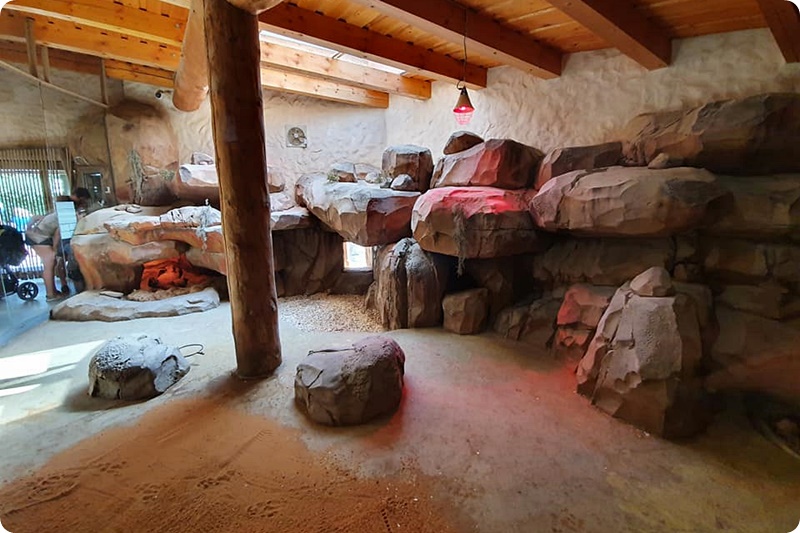
Aardvark (Orycteropus afer) and Rock Hyrax (Procavia capensis) mixed-species exhibit (indoor), 2020
Zoologická zahrada Olomouc, Olomouc, Czech Republic
Photo © Juanjo Po
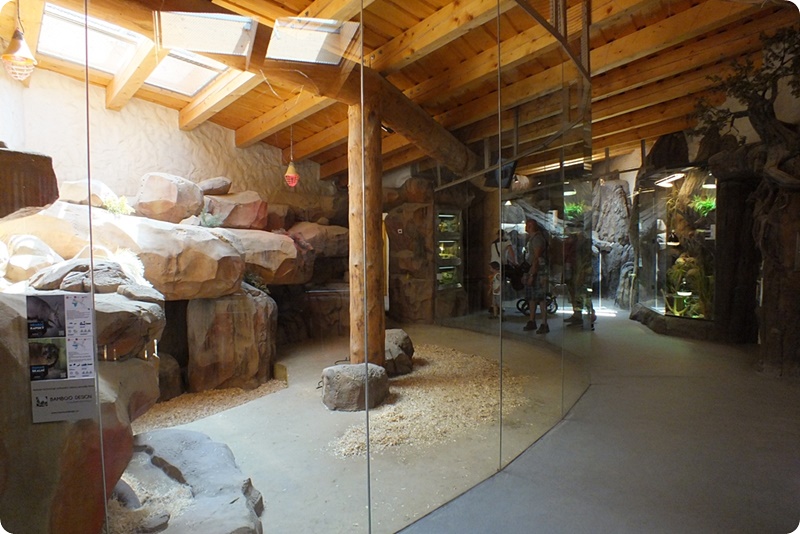
Aardvark (Orycteropus afer) and Rock Hyrax (Procavia capensis) mixed-species exhibit (indoor), 2018
Zoologická zahrada Olomouc, Olomouc, Czech Republic
Photo © Tamás Boros
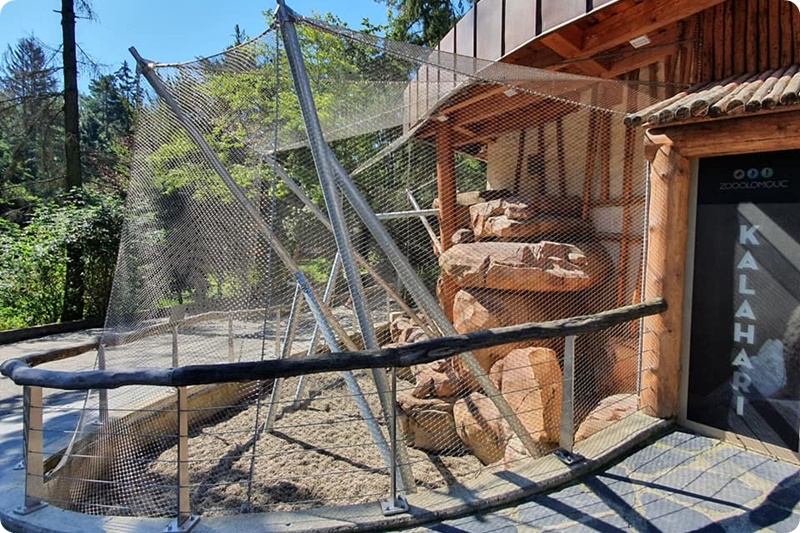
Aardvark (Orycteropus afer) and Rock Hyrax (Procavia capensis) mixed-species exhibit (outdoor), 2020
Zoologická zahrada Olomouc, Olomouc, Czech Republic
Photo © Juanjo Po
Combined species:
- Aardvark, Orycteropus afer
- Rock Hyrax, Procavia capensis
- West African Potto, Perodicticus potto
- Thick-tailed Greater Galago, Otolemur crassicaudatus
- Fennec Fox, Vulpes zerda
Institution(s): Pittsburgh Zoo & PPG Aquarium (Pittsburgh, Pennsylvania, United States of America)
Combined species:
- Aardvark, Orycteropus afer
- Rock Hyrax, Procavia capensis
- Garnett's Greater Galago, Otolemur garnettii
- Spring Hare, Pedetes capensis
- African Brush-tailed Porcupine, Atherurus africanus
Institution(s): Omaha’s Henry Doorly Zoo and Aquarium (Omaha, Nebraska, United States of America)
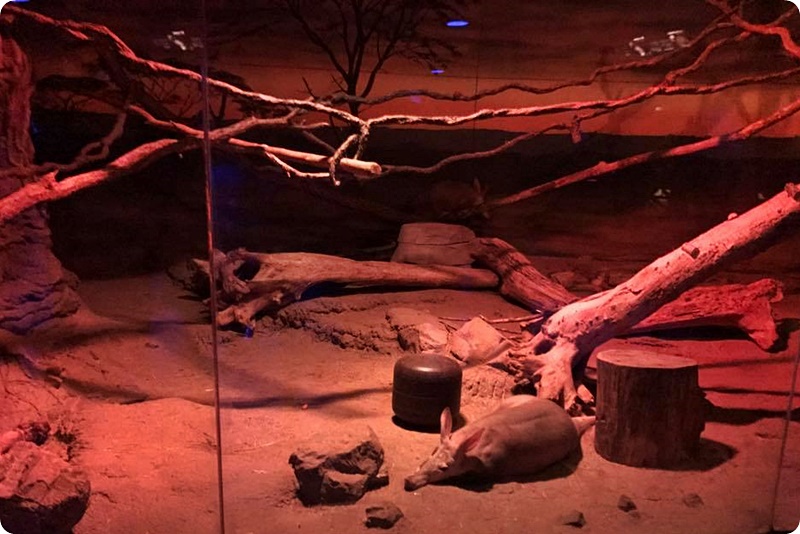
Aardvarks (Orycteropus afer) in a mixed-species exhibit in the nocturnal house 'Mahoney Kingdoms of the Night' (in daylight and nocturnal lighting), 2010 and 2017
Omaha’s Henry Doorly Zoo and Aquarium, Omaha, Nebraska, United States of America
Photos © www.zoochat.com
Combined species:
- Aardvark, Orycteropus afer
- Grey Mouse Lemur, Microcebus murinus
- Northern Lesser Galago, Galago senegalensis
Institution(s): ZOO Antwerpen (Antwerp, Belgium)
Aardvark (Orycteropus afer), Grey Mouse Lemur (Microcebus murinus) and Northern Lesser Galago (Galago senegalensis) mixed-species exhibit in the nocturnal house 'Nocturama' (daylights on), 2010
ZOO Antwerpen, Antwerp, Belgium
Photo © Theo Linders
Combined species:
- Aardvark, Orycteropus afer
- Mongoose Lemur, Eulemur mongoz
- temporarily Spring Hare, Pedetes capensis
- Brazilian Guinea Pig, Cavia aperea
- Indian Flying Fox, Pteropus giganteus
Institution(s): Cincinnati Zoo & Botanical Garden (Cincinnati, Ohio, United States of America)
Combined species:
- Aardvark, Orycteropus afer
- Mongoose Lemur, Eulemur mongoz
- Indian Flying Fox, Pteropus giganteus
- Egyptian Fruit Bat, Rousettus aegyptiacus
unknown institution
Combined species:
- Aardvark, Orycteropus afer
- West African Potto, Perodicticus potto
Institution(s): ZOO Antwerpen (Antwerp, Belgium)
Combined species:
- Aardvark, Orycteropus afer
- West African Potto, Perodicticus potto
- Garnett's Greater Galago, Otolemur garnettii
- Spring Hare, Pedetes capensis
- African Brush-tailed Porcupine, Atherurus africanus
Institution(s): Omaha’s Henry Doorly Zoo and Aquarium (Omaha, Nebraska, United States of America)
Combined species:
- Aardvark, Orycteropus afer
- West African Potto, Perodicticus potto
- Egyptian Fruit Bat, Rousettus aegyptiacus
Institution(s): Cincinnati Zoo & Botanical Garden (Cincinnati, Ohio, United States of America)
Combined species:
- Aardvark, Orycteropus afer
- Northern Lesser Galago, Galago senegalensis
- Spring Hare, Pedetes capensis
Institution(s): ZOO Antwerpen (Antwerp, Belgium), Zoologischer Garten Berlin (Berlin, Germany), Zoo Frankfurt (Frankfurt on the Main, Germany)
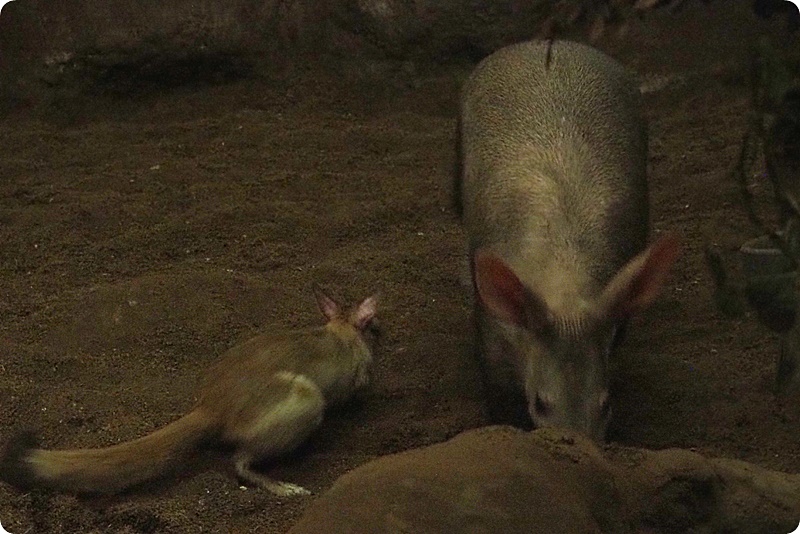
Aardvark (Orycteropus afer) and Spring Hare (Pedetes capensis) in the nocturnal house 'Nocturama', 2019
ZOO Antwerpen, Antwerp, Belgium
Photo © Kevin B.
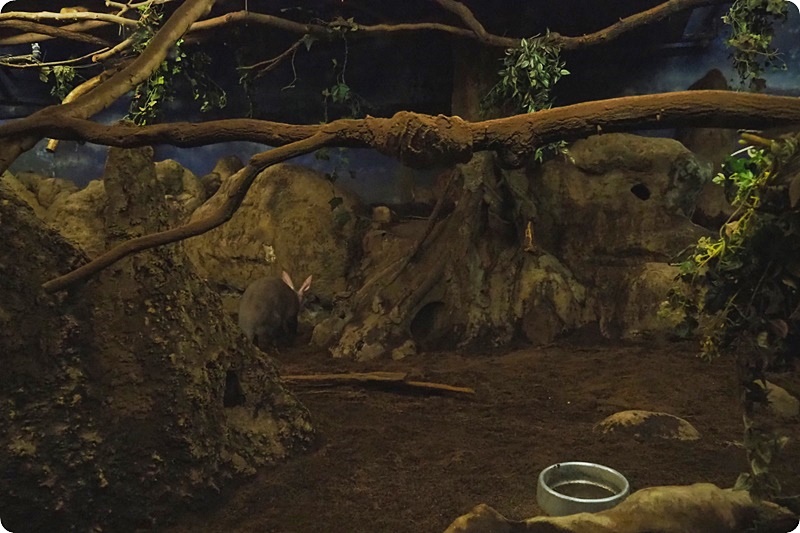
Aardvark (Orycteropus afer), Northern Lesser Galago (Galago senegalensis) and Spring Hare (Pedetes capensis) mixed-species exhibit in the nocturnal house 'Nocturama' (daylights on), 2019
ZOO Antwerpen, Antwerp, Belgium
Photo © Kevin B.
Aardvark (Orycteropus afer), Northern Lesser Galago (Galago senegalensis) and Spring Hare (Pedetes capensis) mixed-species exhibit in the nocturnal house 'Nocturama' (daylights on), 2018
ZOO Antwerpen, Antwerp, Belgium
Photo © Theo Linders
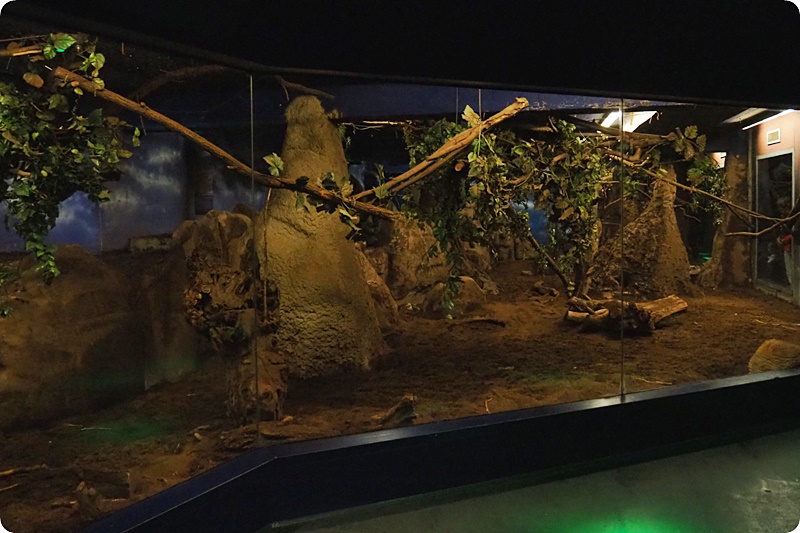
Aardvark (Orycteropus afer), Northern Lesser Galago (Galago senegalensis) and Spring Hare (Pedetes capensis) mixed-species exhibit in the nocturnal house 'Nocturama' (daylights on), 2019
ZOO Antwerpen, Antwerp, Belgium
Photo © Kevin B.
Aardvark (Orycteropus afer) and Spring Hares (Pedetes capensis) in the nocturnal house 'Creatures of the Night', 2017
Zoologischer Garten Berlin, Berlin, Germany
Photos © www.zoochat.com
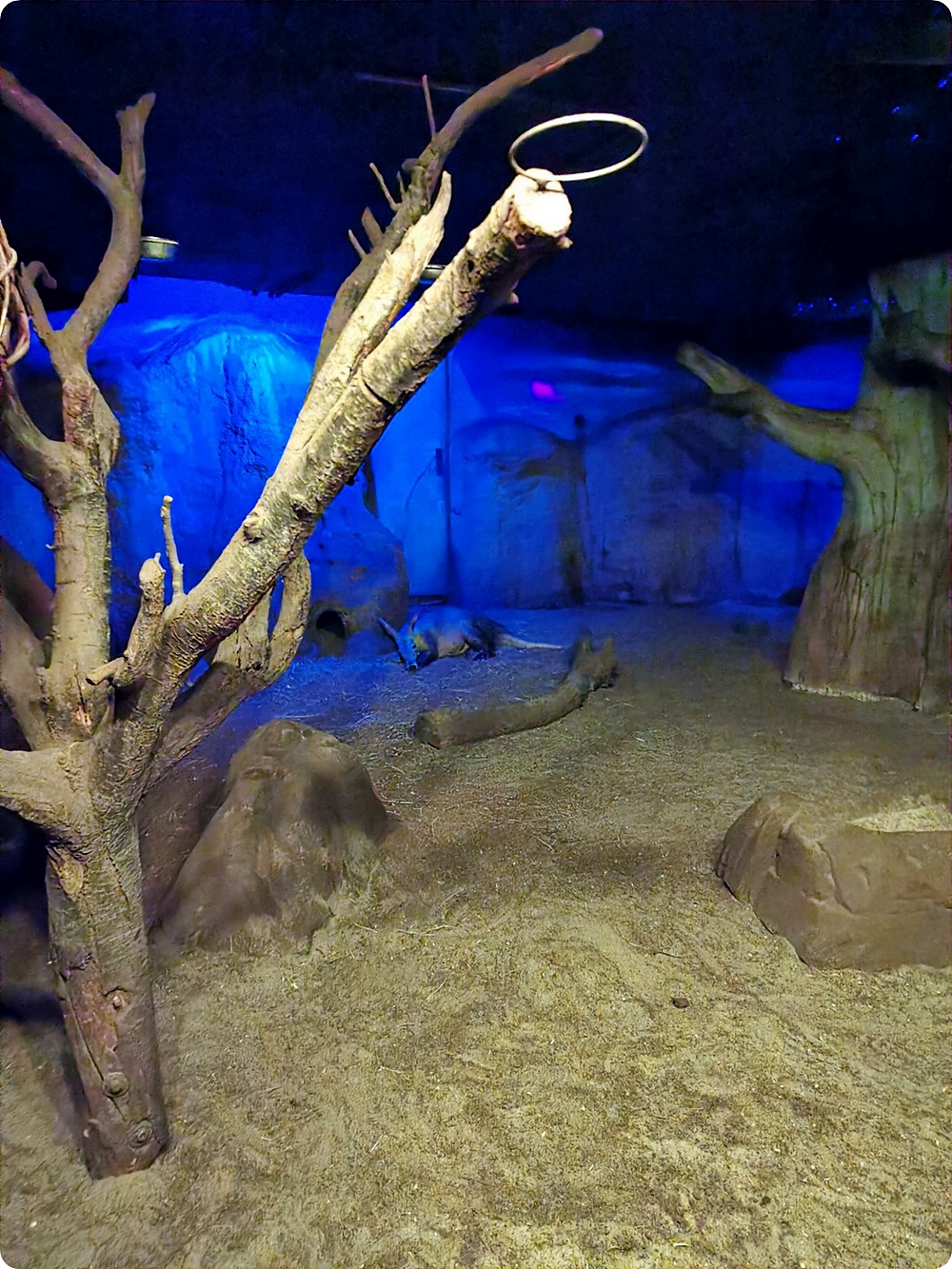
Aardvark (Orycteropus afer), Northern Lesser Galago (Galago senegalensis) and Spring Hare (Pedetes capensis) mixed-species exhibit in the nocturnal house 'Creatures of the Night', 2022
Zoologischer Garten Berlin, Berlin, Germany
Photo © João Pedro Meireles
Aardvark (Orycteropus afer), Northern Lesser Galago (Galago senegalensis) and Spring Hare (Pedetes capensis) mixed-species exhibit in the nocturnal house 'Creatures of the Night' (daylights on), 2008
Zoologischer Garten Berlin, Berlin, Germany
Photo © www.zoochat.com
Aardvark (Orycteropus afer), Northern Lesser Galago (Galago senegalensis) and Spring Hare (Pedetes capensis) mixed-species exhibit in the nocturnal house 'Grzimek House', 2014 and 2018
Zoo Frankfurt, Frankfurt on the Main, Germany
Photos © Theo Linders
Combined species:
- Aardvark, Orycteropus afer
- Greater Galago, Otolemur sp.
Institution(s): ZOO Antwerpen (Antwerp, Belgium)
Combined species:
- Aardvark, Orycteropus afer
- Thick-tailed Greater Galago, Otolemur crassicaudatus
Institution(s): ARTIS Amsterdam Royal Zoo (Amsterdam, the Netherlands)
Combined species:
- Aardvark, Orycteropus afer
- Thick-tailed Greater Galago, Otolemur crassicaudatus
- Spring Hare, Pedetes capensis
Institution(s): Zoologischer Garten Berlin (Berlin, Germany)
Combined species:
- Aardvark, Orycteropus afer
- Garnett's Greater Galago, Otolemur garnettii
Institution(s): Zoologická a botanická zahrada města Plzně (Pilsen, Czech Republic), Memphis Zoo (Memphis, Tennessee, United States of America)
Aardvark (Orycteropus afer) and Garnett's Greater Galago (Otolemur garnettii) mixed-species exhibit in the nocturnal house 'Animals of the Night' (daylights on), 2021
Memphis Zoo, Memphis, Tennessee, United States of America
Photo © www.zoochat.com
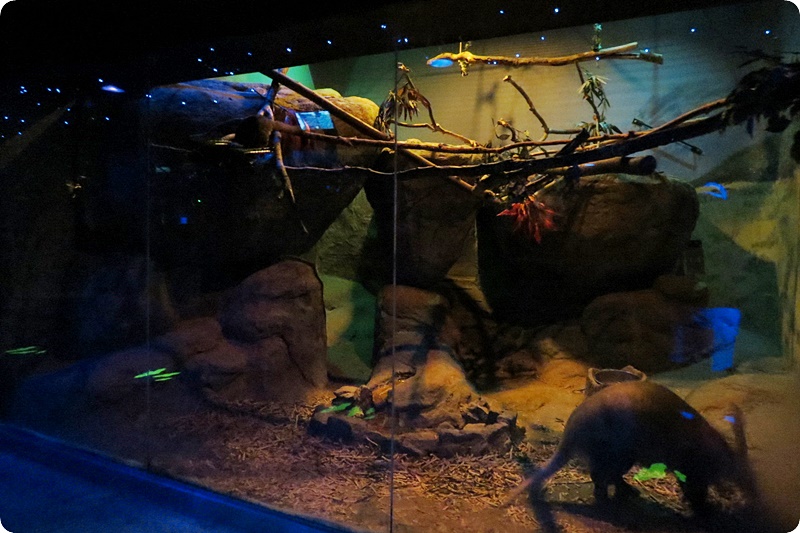
Aardvark (Orycteropus afer) and Garnett's Greater Galago (Otolemur garnettii) mixed-species exhibit in the nocturnal house 'Animals of the Night', 2018
Memphis Zoo, Memphis, Tennessee, United States of America
Photo © David Freely
Combined species:
- Aardvark, Orycteropus afer
- Garnett's Greater Galago, Otolemur garnettii
- African Brush-tailed Porcupine, Atherurus africanus
- Meerkat, Suricata suricatta
Institution(s): Omaha’s Henry Doorly Zoo and Aquarium (Omaha, Nebraska, United States of America)
Combined species:
- Aardvark, Orycteropus afer
- Garnett's Greater Galago, Otolemur garnettii
- Indian Flying Fox, Pteropus giganteus
Institution(s): Cincinnati Zoo & Botanical Garden (Cincinnati, Ohio, United States of America)
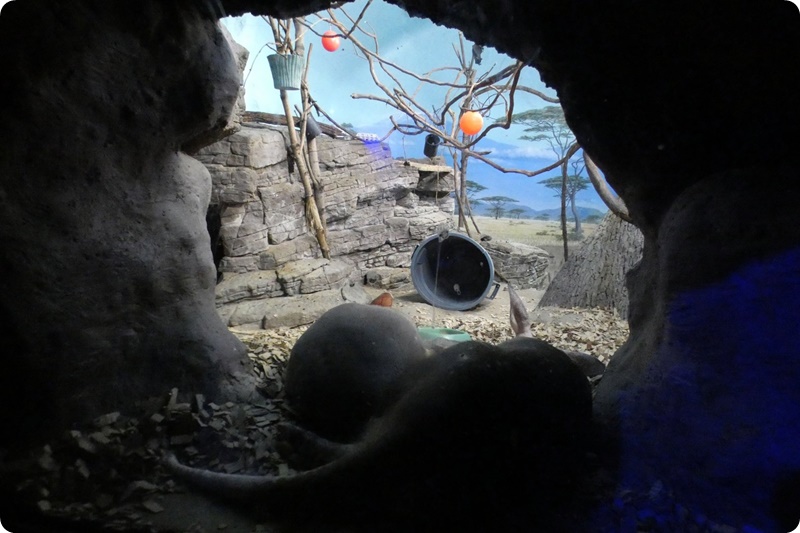
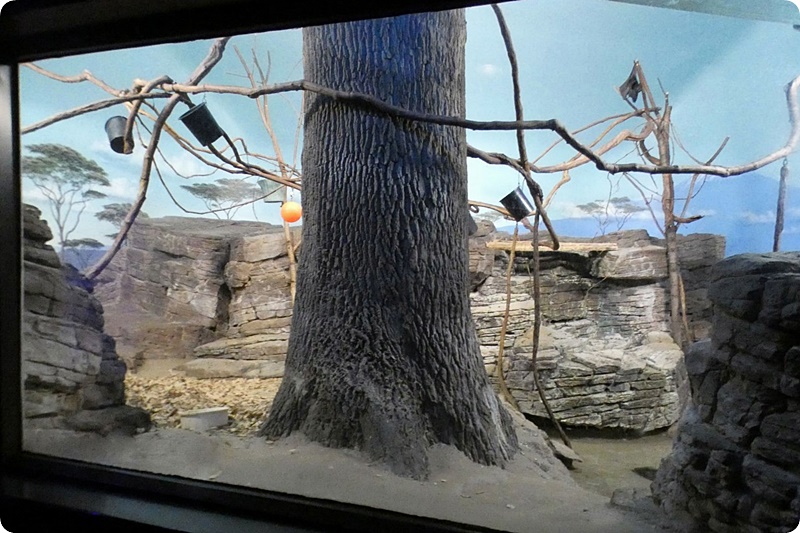
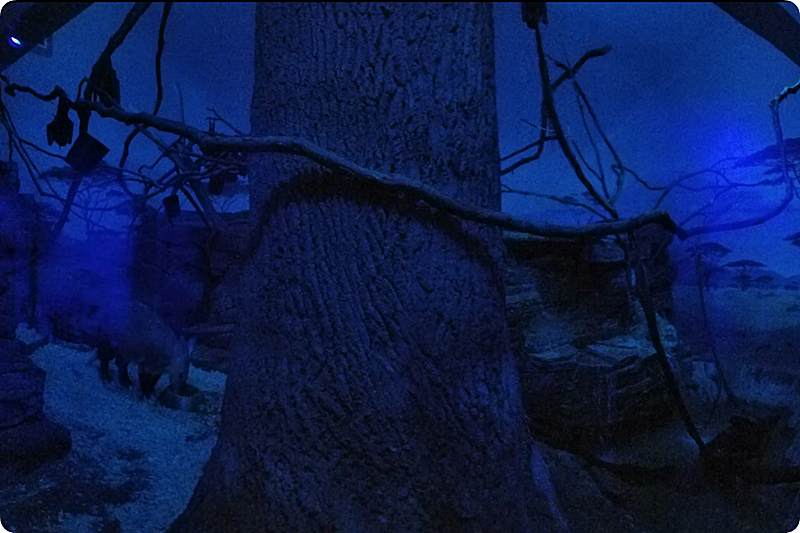
Aardvark (Orycteropus afer), Garnett's Greater Galago (Otolemur garnettii) and Indian Flying Fox (Pteropus giganteus) mixed-species exhibit in the nocturnal house 'Night Hunters' (in daylight and nocturnal lighting), 2021, 2012, 2021 and 2018
Cincinnati Zoo & Botanical Garden, Cincinnati, Ohio, United States of America
Photos © Zachary Handel
Combined species:
- Aardvark, Orycteropus afer
- Guenon, Cercopithecus sp.
unknown institution
Combined species:
- Aardvark, Orycteropus afer
- Diana Monkey, Cercopithecus diana
unknown institution
Combined species:
- Aardvark, Orycteropus afer
- South African Ground Squirrel, Xerus inauris
- Common Dwarf Mongoose, Helogale parvula
- Kirk's Dik-dik, Madoqua kirkii
- several free-flying African bird species, e.g. Cattle Egret, Bubulcus ibis, Hamerkop, Scopus umbretta, Hadada Ibis, Bostrychia hagedash, White-faced Whistling-duck, Dendrocygna viduata, Red-billed Teal, Anas erythrorhyncha, Marbled Teal, Marmaronetta angustirostris, Brown-faced Go-away-bird, Corythaixoides personatus, Village Weaver, Ploceus cucullatus
Institution(s): ZOO Wrocław (Wrocław, Poland)
Combined species:
- Aardvark, Orycteropus afer
- Spring Hare, Pedetes capensis
Institution(s): Brookfield Zoo (Brookfield, Illinois, United States of America)
Combined species:
- Aardvark, Orycteropus afer
- Spring Hare, Pedetes capensis
- Egyptian Fruit Bat, Rousettus aegyptiacus
Institution(s): Zoo Saarbrücken (Saarbrücken, Germany)
Combined species:
- Aardvark, Orycteropus afer
- African Brush-tailed Porcupine, Atherurus africanus
Institution(s): Randers Regnskov (Randers, Denmark)
Combined species:
- Aardvark, Orycteropus afer
- Cape Porcupine, Hystrix africaeaustralis
- Meerkat, Suricata suricatta
Institution(s): ZSL Whipsnade Zoo (Dunstable, United Kingdom)
Combined species:
- Aardvark, Orycteropus afer
- Rodrigues Flying Fox, Pteropus rodricensis
- Egyptian Fruit Bat, Rousettus aegyptiacus
- Tokay Gecko, Gekko gecko
Institution(s): San Diego Zoo (San Diego, California, United States of America)
Combined species:
- Aardvark, Orycteropus afer
- Egyptian Fruit Bat, Rousettus aegyptiacus
Institution(s): Xantus János Állatkert (Győr, Hungary), Zoo Saarbrücken (Saarbrücken, Germany)
Combined species:
- Aardvark, Orycteropus afer
- Egyptian Fruit Bat, Rousettus aegyptiacus
- Tokay Gecko, Gekko gecko
Institution(s): Ogród Zoologiczny w Poznaniu – Nowe Zoo (Poznan, Poland)
Combined species:
- Aardvark, Orycteropus afer
- Aardwolf, Proteles cristata
Institution(s): Zoo Frankfurt (Frankfurt on the Main, Germany)
Combined species:
- Aardvark, Orycteropus afer
- Aardwolf, Proteles cristata
- Pearl-spotted Owlet, Glaucidium perlatum
- Tawny Frogmouth, Podargus strigoides
Institution(s): Zoo Frankfurt (Frankfurt on the Main, Germany)
Combined species:
- Aardvark, Orycteropus afer
- Meerkat, Suricata suricatta
Institution(s): Africa Alive Zoological Reserve (Kessingland, United Kingdom), Blackpool Zoo (Blackpool, United Kingdom), Chester Zoo (Chester, United Kingdom), ZSL London Zoo (London, United Kingdom), Minnesota Zoo (Apple Valley, Minnesota, United States of America), Philadelphia Zoo (Philadelphia, Pennsylvania, United States of America)
Aardvark (Orycteropus afer) and Meerkat (Suricata suricatta), 2012
Chester Zoo, Chester, United Kingdom
Photo © Christopher Holland
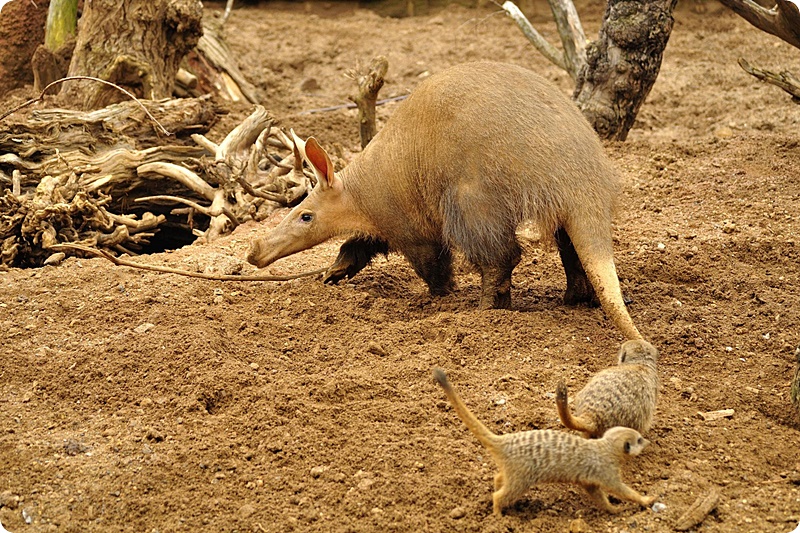
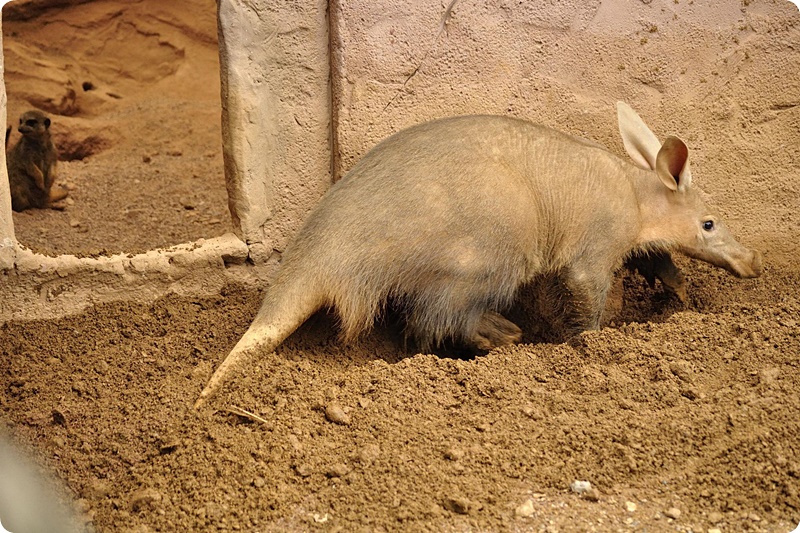
Aardvark (Orycteropus afer) and Meerkats (Suricata suricatta), 2012
Chester Zoo, Chester, United Kingdom
Photos © Richard Southwell
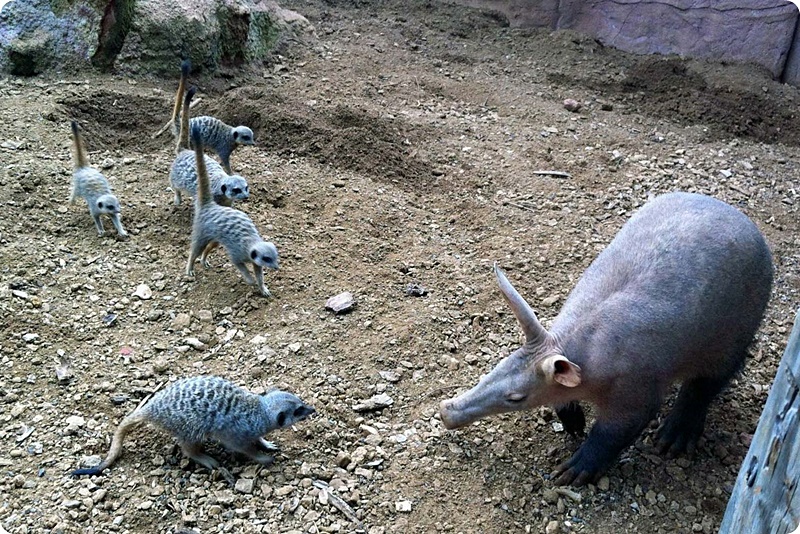
Aardvark (Orycteropus afer) and Meerkats (Suricata suricatta), 2012
Chester Zoo, Chester, United Kingdom
Photo © www.zoochat.com
Aardvark (Orycteropus afer) and Meerkat (Suricata suricatta) mixed-species exhibit, 2020
Chester Zoo, Chester, United Kingdom
Photos © Malcolm Huckvale
Aardvark (Orycteropus afer) and Meerkats (Suricata suricatta), 2009
ZSL London Zoo, London, United Kingdom
Photos © Krisztián Svábik
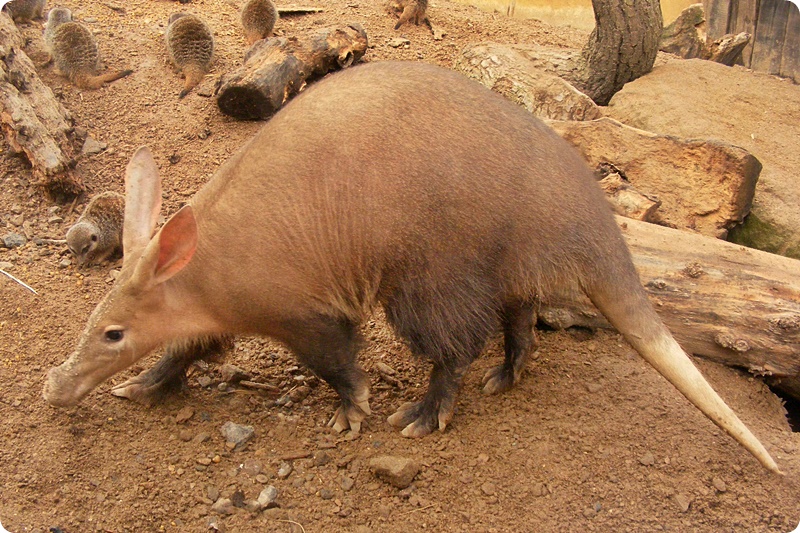
Aardvark (Orycteropus afer) and Meerkats (Suricata suricatta), 2013
ZSL London Zoo, London, United Kingdom
Photo © Mo Hassan
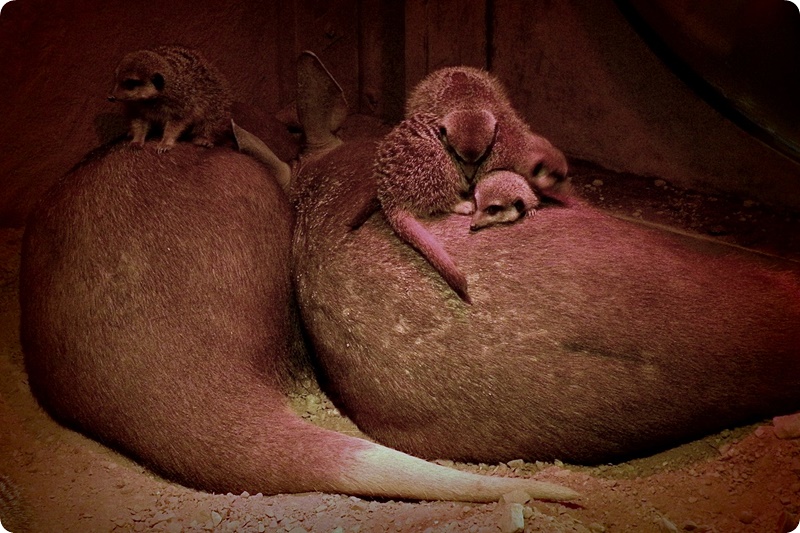
Aardvarks (Orycteropus afer) and Meerkats (Suricata suricatta), 2009
ZSL London Zoo, London, United Kingdom
Photo © Esther Simpson
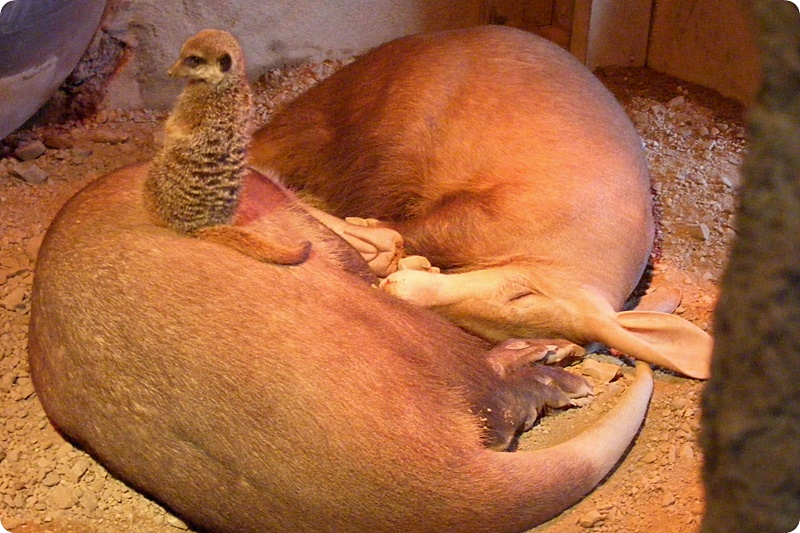
Aardvarks (Orycteropus afer) and Meerkat (Suricata suricatta), 2013
ZSL London Zoo, London, United Kingdom
Photo © Mo Hassan
Aardvarks (Orycteropus afer) and Meerkats (Suricata suricatta), 2010
ZSL London Zoo, London, United Kingdom
Photo © Nayer Youakim
Aardvark (Orycteropus afer) and Meerkat (Suricata suricatta) mixed-species exhibit, 2009
ZSL London Zoo, London, United Kingdom
Photo © Nayer Youakim
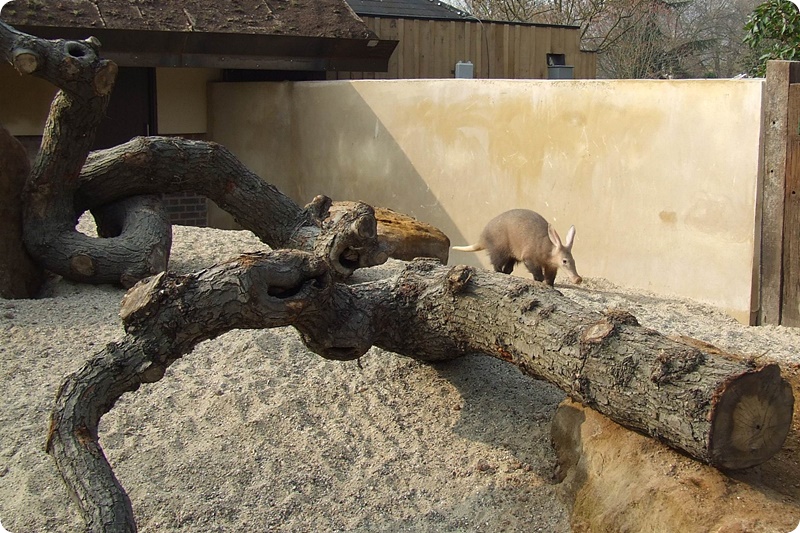
Aardvark (Orycteropus afer) and Meerkat (Suricata suricatta) mixed-species exhibit, 2009
ZSL London Zoo, London, United Kingdom
Photos © Krisztián Svábik
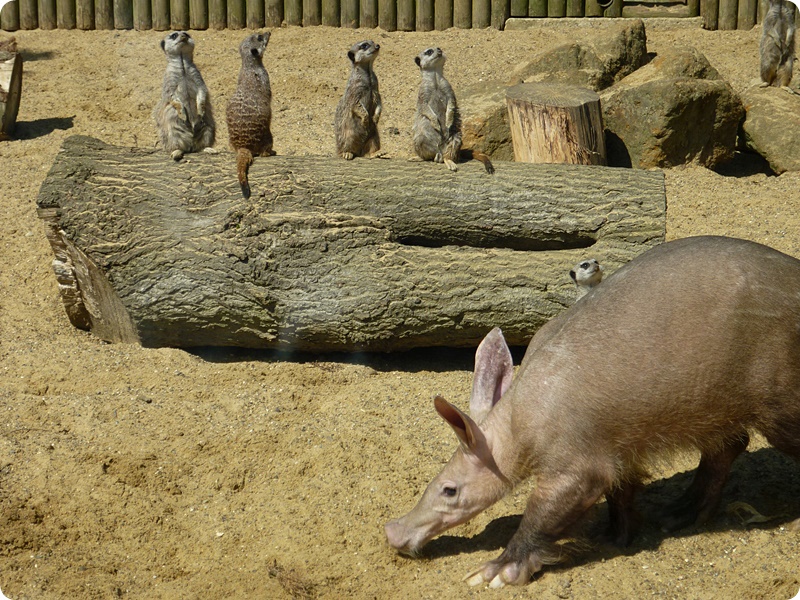
Aardvark (Orycteropus afer) and Meerkats (Suricata suricatta), 2013
Africa Alive Zoological Reserve, Kessingland, United Kingdom
Photo © J. B.
Aardvarks (Orycteropus afer) and Meerkats (Suricata suricatta), 2011
Africa Alive Zoological Reserve, Kessingland, United Kingdom
Photo © www.zoochat.com
Aardvark (Orycteropus afer) and Meerkat (Suricata suricatta) mixed-species exhibit, 2009
Africa Alive Zoological Reserve, Kessingland, United Kingdom
Photos © Krisztián Svábik
Combined species:
- Aardvark, Orycteropus afer
- Meerkat, Suricata suricatta
- Bat-eared Fox, Otocyon megalotis megalotis
Institution(s): Bioparc de Doué-la-Fontaine (Doué-la-Fontaine, France)
Aardvark (Orycteropus afer), Meerkat (Suricata suricatta) and Bat-eared Fox (Otocyon megalotis megalotis) mixed-species exhibit, 2020
Bioparc de Doué-la-Fontaine, Doué-la-Fontaine, France
Photo © Theo Linders
Combined species:
- Aardvark, Orycteropus afer
- Common Dwarf Mongoose, Helogale parvula
- several free-flying African bird species, e.g. Cattle Egret, Bubulcus ibis, Hamerkop, Scopus umbretta, Hadada Ibis, Bostrychia hagedash, White-faced Whistling-duck, Dendrocygna viduata, Red-billed Teal, Anas erythrorhyncha, Marbled Teal, Marmaronetta angustirostris, Brown-faced Go-away-bird, Corythaixoides personatus, Village Weaver, Ploceus cucullatus
Institution(s): ZOO Wrocław (Wrocław, Poland)
Aardvark (Orycteropus afer) and Common Dwarf Mongoose (Helogale parvula) mixed-species exhibit in the Afrykarium, 2015
ZOO Wrocław, Wrocław, Poland
Photo © Krisztián Svábik
Combined species:
- Aardvark, Orycteropus afer
- Common Cusimanse, Crossarchus obscurus
Institution(s): Shepreth Wildlife Park (Shepreth, United Kingdom)
Aardvark (Orycteropus afer) and Common Cusimanse (Crossarchus obscurus) mixed-species exhibit, 2020
Shepreth Wildlife Park, Shepreth, United Kingdom
Photo © Edward Breeze
Combined species:
- Aardvark, Orycteropus afer
- Bat-eared Fox, Otocyon megalotis megalotis
Institution(s): Bioparc Valéncia (Valencia, Spain)
Combined species:
- Aardvark, Orycteropus afer
- Fennec Fox, Vulpes zerda
Institution(s): Pittsburgh Zoo & PPG Aquarium (Pittsburgh, Pennsylvania, United States of America), Reston Zoo (Reston, Virginia, United States of America), Sacramento Zoo (Sacramento, California, United States of America)
Combined species:
- Aardvark, Orycteropus afer
- Kirk's Dik-dik, Madoqua kirkii
Institution(s): Faunia (Madrid, Spain), Zoologická zahrada hl. m. Prahy (Prague, Czech Republic)
Aardvark (Orycteropus afer) and Kirk's Dik-dik (Madoqua kirkii) mixed-species exhibit in the nocturnal house 'Silent Shadows', 2016
Faunia, Madrid, Spain
Photos © Malcolm Huckvale
Combined species:
- Aardvark, Orycteropus afer
- Maxwell's Duiker, Philantomba maxwellii
- Northern White-faced Owl, Ptilopsis leucotis
Institution(s): Bronx Zoo (New York, New York, United States of America)
Combined species:
- Aardvark, Orycteropus afer
- Congo Blue Duiker, Philantomba monticola congica
- several free-flying bird species (approx. 35 different species)
Institution(s): Koninklijke Burgers' Zoo (Arnhem, the Netherlands)
Aardvarks (Orycteropus afer) and Congo Blue Duiker (Philantomba monticola congica), 2006
Koninklijke Burgers' Zoo, Arnhem, the Netherlands
Photo © Marc Damen
Combined species:
- Aardvark, Orycteropus afer
- Southern Ground-hornbill, Bucorvus leadbeateri
Institution(s): Bioparc de Doué-la-Fontaine (Doué-la-Fontaine, France)
Combined species:
- Aardvark, Orycteropus afer
- Red-billed Hornbill, Tockus erythrorhynchus
- Village Weaver, Ploceus cucullatus
Institution(s): Zoologická zahrada hl. m. Prahy (Prague, Czech Republic)
Aardvark (Orycteropus afer), Red-billed Hornbill (Tockus erythrorhynchus) and Village Weaver (Ploceus cucullatus) mixed-species exhibit, 2014
Zoologická zahrada hl. m. Prahy, Prague, Czech Republic
Photos © Krisztián Svábik
Combined species:
- Aardvark, Orycteropus afer
- Northern White-faced Owl, Ptilopsis leucotis
Institution(s): Bronx Zoo (New York, New York, United States of America)
Combined species:
- Aardvark, Orycteropus afer
- several free-flying bird species (approx. 35 different species)
Institution(s): Koninklijke Burgers' Zoo (Arnhem, the Netherlands)
Aardvark (Orycteropus afer) exhibit inside Burgers' Bush, 2009
Koninklijke Burgers' Zoo, Arnhem, the Netherlands
Photo © Krisztián Svábik
LIST OF ZOOLOGICAL INSTITUTES WITH MIXED-SPECIES EXHIBITS - ORYCTEROPODIDAE
Aardvark, Orycteropus afer
Belgium
ZOO Antwerpen, Antwerp, Belgium
Czech Republic
Zoologická a botanická zahrada města Plzně, Pilsen, Czech Republic
Zoologická zahrada hl. m. Prahy, Prague, Czech Republic
Zoologická zahrada Olomouc, Olomouc, Czech Republic
Denmark
Randers Regnskov, Randers, Denmark
France
Bioparc de Doué-la-Fontaine, Doué-la-Fontaine, France
Germany
Zoo Frankfurt, Frankfurt on the Main, Germany
Zoologischer Garten Berlin, Berlin, Germany
Zoo Saarbrücken, Saarbrücken, Germany
Hungary
Xantus János Állatkert, Győr, Hungary
Netherlands
ARTIS Amsterdam Royal Zoo, Amsterdam, the Netherlands
Koninklijke Burgers' Zoo, Arnhem, the Netherlands
Poland
Ogród Zoologiczny w Poznaniu – Nowe Zoo, Poznan, Poland
ZOO Wrocław, Wrocław, Poland
Spain
Bioparc Valéncia, Valencia, Spain
Faunia, Madrid, Spain
United Kingdom
Africa Alive Zoological Reserve, Kessingland, United Kingdom
Blackpool Zoo, Blackpool, United Kingdom
Chester Zoo, Chester, United Kingdom
Colchester Zoo, Colchester, United Kingdom
Shepreth Wildlife Park, Shepreth, United Kingdom
ZSL London Zoo, London, United Kingdom
ZSL Whipsnade Zoo, Dunstable, United Kingdom
United States of America
Bronx Zoo, New York, New York, United States of America
Brookfield Zoo, Brookfield, Illinois, United States of America
Cincinnati Zoo & Botanical Garden, Cincinnati, Ohio, United States of America
Memphis Zoo, Memphis, Tennessee, United States of America
Minnesota Zoo, Apple Valley, Minnesota, United States of America
Omaha’s Henry Doorly Zoo and Aquarium, Omaha, Nebraska, United States of America
Philadelpia Zoo, Philadelphia, Pennsylvania, United States of America
Pittsburgh Zoo & PPG Aquarium, Pittsburgh, Pennsylvania, United States of America
Reston Zoo, Reston, Virginia, United States of America
Sacramento Zoo, Sacramento, California, United States of America
San Diego Zoo, San Diego, California, United States of America
SUMMARIZE THE EXPERIENCES
The study lists species combinations and mixed exhibits with the only one member of family Orycteropodidae.
Altogether 55 mixed exhibits with Aardvark (Orycteropus afer) have been collected from 34 zoological institutions worldwide until October 2022.
In regard to species combinations Aardvark has been socialized with 42 different species.
In general it can be concluded that the Aardvark in most cases is uncomplicated in reference to the socialisation with other animals.
Many of the listed mixed-species exhibits with Aardvarks take place in nocturnal houses. Due to their relatively big body size and not least because of their willingness to move, Aardvark is among the species that are far better kept conventionally with the possibility of using an outdoor enclosure. Fortunately, there has been a trend in Europe for some years now to no longer keep this species in nocturnal houses. The limited space in a noctarium simply cannot provide the necessary enclosure sizes for them. For some years, these animals have been kept conventionally in the USA and in the United Kingdom with great success (AMEND 2018). This “new type” of exhibitry for them means that the earlier classic examples of socialize them with other night-active and smaller species such as galagoes or bats are not more possible, instead of this in many cases they can be kept together with diurnal mongooses such Meerkat which is/was the situation in ZSL London and Whipsnade Zoo, Chester Zoo, Blackpool Zoo and Africa Alive Zoological Reserve in the United Kingdom. However, we must also note that in reference to the activity pattern Aardvark is nocturnal with only occasional afternoon activity during winter in areas where nights get cold. They often remain active all night and may only return to their burrows at dawn, but they rarely stay above ground after sunrise (TAYLOR 2011).
In the Africa Dome of Randers Regnskov Tropical Zoo Aardvarks, Bush Hyraxes and African Brush-tailed Porcupines were kept together where hyraxes had access to the whole hall. Currently the zoo no longer keeps hyraxes but they still exhibit the Aardvarks and African Brush-tailed Porcupines in the same enclosure. The porcupine actually just gave birth to a baby and they seem to be thriving. Neither negative nor positive interactions have not been reported between the two species, they just live peacefully together (WINTHER LASSEN 2022, pers. comm.).
In Colchester Zoo the Aardvark & Rock Hyrax combination is successful. This mixed species set-up is not complicated as the Aardvarks are typically asleep during the day whilst the hyraxes are active (BARWICK 2020, pers. comm.).
Zoo Olomouc has kept a pair of Aardvark and two male Rock Hyraxes together only for several days. There was not any problem arises but the management decided to make some small changes in the indoor facility so that visitors could see hyraxes better and so the staff replaced them. After some time Aardvark was born and an infectious disease was occured in the building where hyrax males were placed, so the institution did not put them back (VESELÁ 2020, pers. comm.).
In the 1980s in Pittsburgh Zoo there were an Aardvark and Crested Porcupine enclosures next to each other. The whole indoor exhibit was approximately 12 meters in length and was divided in two sections by a low gunite wall. This divider was designed to keep the Aardvarks on one side and the Crested Porcupines on the other and constructed to minimize the interaction between them. The other animals in the exhibit – as Rock Hyrax, West African Potto, Thick-tailed Greater Galago and Fennec Fox – were free to cross over to any side they desired. The light cycle was reversed to increase activity, as the building was totally underground. There was not much aggression amongst the animals (KACPRZYK 2022, pers. comm.).
In many cases Aardvarks are socialized with different species of galagoes without any problem. In ZOO Antwerpen combination with Northern Lesser Galagoes was successful: in the beginning everything went well and breeding too, but later on the institution lost a lot of youngsters and adults due to health problems. The management believed dust – due to bad ventilation – and bad air humidity caused these health problems and was not related to this combination of species. The enclosure was small (120 m²) and if the zoo would ever try again ventilation and humidity should be optimal. During the cohabitation with Greater Galagoes also no problems have been recorded (LAFAUT 2022, pers. comm.).
Another type of interaction was observed when guenons chased the Aardvarks away from their nesting sites once the Aardvarks came too close (KNÖTHIG 2005).
In most cases there were no interactions reported between Aardvark and other species. The Spring Hares, however, were often injured because of Aardvarks stepping on them (KNÖTHIG 2005). Worth mentioning another interaction between the two species in reference to nutrition in the nocturnal exhibit in Zoo Berlin. KLÖS (1986) was reported that Aardvarks like the food what was offered for the Spring Hares and one of the Aardvarks on a regular basis ate pieces of apples, cereal and sunflower seeds, furthermore pellets (PIES-SCHULZ-HOFEN 1996). In ZOO Antwerpen it was reported to be such a very attractive combination for visitors. The Spring Hares also bred but hand rearing was needed (LAFAUT 2022, pers. comm.).
In ZSL Whipsnade Zoo a pair of Aardvark will be joined by two Cape Porcupines and two Meerkats in the new labyrinthine enclosure. The exhibit has lots of flexibility with different spaces that can either be joined up or separated, so the staff will take our time letting all the animals get to know each other and decide the best sleeping and favourite places for them all (ZSL 2022).
20 years ago, in 55% of the cases Aardvarks mostly socialized with different species of bats. Zoo Saarbrücken was an early example where Aardvarks and Egyptian Fruit Bats were kept together in a relatively small, 25 m² enclosure since 1978. The new zoo in Poznan had the same combination with the addition of Tokay Geckos in a smaller, 22 m² exhibit since 1995 (HAMMER 2002).
In a nocturnal exhibit at Zoo Frankfurt the socialization of Aardvarks and Aardwolves was really successful for a long time that was established in 1978. Aardwolves were the submissive species and sometimes showed threat behaviour, but no aggression. Inside the 72 m² enclosure each of the Aardvarks had their own boxes for retreat (HAMMER 2002). Mild stress was also present between the species due to the common use of the underground holes as the Aardwolves went into the Aardvarks’ burrows (KNÖTHIG 2005).
Housing diurnal mongoose species – such as Common Dwarf Mongoose, Common Cusimanse and Meerkat – with nocturnal species, such as Aardvarks, means that animals generally use the exhibit at different times of the day. As mentioned beforehand many zoological institutes have tried this type of combination, where primarily Meerkat is housed together with Aardvark. In Philadelphia Zoo Meerkats had climbing structures and hollowed logs the Aardvark did not have access to or fit into, furthermore, a plexiglass wall with a mongoose-sized access divided the space so that the Meerkats had an area of their own (HAMMER 2002). Aardvarks and Meerkats have been exhibited together; however, Meerkat aggression towards the Aardvark was observed over food and space. With time, these conflicts resolved themselves when the Aardvark learned to avoid the small carnivores (AZA Small Carnivore TAG 2011). This combination in Philadelphia Zoo worked well for many years and the institution successfully bred both species in this setup. The mix worked because Meerkats had some spaces they could go to avoid the Aardvarks when they wanted to, furthermore Aardvarks were fed in a separate area so Meerkats would not steal the food or act aggressively towards them (STERN 2022, pers. comm.). In Blackpool Zoo the only reason they stopped this cohabitation was because the enclosure was not designed for Meerkats, only Aardvark and they were able to get into wall cavities, the cost of stopping this was too high (WOOLHAM 2022, pers. comm.).
Zoo Praha keeps their Aardvarks together with Kirk's Dik-diks. Earlier different birds were also exhibited in the hall but these were never bred and escaped, so later on all of them removed (BRANDL 2020, pers. comm.).
Aardvarks were successfully mixed with Congo Blue Duikers in the Burgers’ Bush in Arnhem. A male duiker was really interested in the Aardvarks and so were the Aardvarks. There was a small corner in the exhibit which was not accessible for the Aardvarks to give the duiker a safe place to sleep (DAMEN 2020, pers. comm.) This combination was stopped because of the behaviour of the duiker towards visitors as he was too friendly (IDOE 2022, pers. comm.). It is worth mentioning that there are several free-flying birds that live in the Burgers’ Bush so many of them can enter into the Aardvark enclosure.
In the Bronx Zoo Aardvarks (1.0 or 0.1), Maxwell’s Duikers (1.1 or 1.0) and Northern White-faced Owls (1.1.2 or 1.1) have been successfully mixed since 2012. This nocturnal exhibit was specifically built for Aardvark. The zoo has not bred the duikers since mixing them with Aardvarks and have never had more than one Aardvark in this mixed-species exhibit. It took a plenty of time to get the duikers acclimated to this enclosure (AZA Ungulate TAGs 2017).
Future plans
Besides the abovementioned combinations in Burgers’ Zoo if the management is going to redesign their exhibit will create more of a mix then the current one, think of e.g. elephant shrews, galagoes and birds (IDOE 2022, pers. comm.).
Papiliorama had planned to keep their Aardvarks together with Northern Lesser Galagoes and Springhares – similar to what has been tried in Antwerp, Berlin and Frankfurt – but before that the institution needs to make some enclosure adjustments (RÜEGG 2022, pers. comm.).
Kölner Zoo has so far not mixed their Aardvarks with other species, but the management is thinking of either Garnett's Greater Galago or Fennec Fox. The issue is to cover the enclosure so that the latter smaller species cannot escape (SLIWA 2020, pers. comm.).
Jersey Zoo in the Channel Islands plans to keep their Aardvark together with Meerkats in the near future (WORMELL 2022, pers. comm.).
In Blackpool Zoo there is a plan to bring in some Bat-eared Fox and run them with the Aardvark next year (WOOLHAM 2022, pers. comm.).
Although this is not a future plan which belong to a certain institution it is worth mentioning that before Bioparc de Doué-la-Fontaine and Bioparc Valéncia have had experience with this mix, the Aardvark and Bat-eared Fox combination was already planned formerly due to educational purposes in a so-called “Botswana House – Pavilion of Insectivorous Animals” concept originated from 2006, where the main theme was to show in parallel specialized insectivorous species from different taxa, plus a connected special food chain setting as well.
ACKNOWLEDGEMENTS
I would like to thank all the persons very much who helped to improve this short summary with providing information and photographs as well, in particular:
Clive BARWICK Curator (Colchester Zoo, Colchester, United Kingdom), Dr. Pavel BRANDL Curator (Zoologická zahrada hl. m. Prahy, Prague, Czech Republic), Marc DAMEN Director (Nationale Vereniging de Zonnebloem, Breda, the Netherlands) and former Director General/CEO (Diergaarde Blijdorp, Rotterdam, the Netherlands), Monika FIBY Landscape Architect, Zoo Designer and Consultant (ZooLex Zoo Design non-profit Organization, Manager and Chief Editor), Jutta HEUER Scientific Assistant (Zoologischer Garten Halle, Halle, Germany), Sander HOFMAN General Curator (ZOO Antwerpen, Antwerp and ZOO Planckendael, Mechelen, Belgium), Willeke HUIZINGA Owner of Wildlife's Welfare (Wildlife's Welfare Consultancy, Nijmegen, Gelderland, the Netherlands) and former Curator of Bush, Desert and Mangrove and former European StudBook keeper (ESB) of the Aardvark (Koninklijke Burgers’ Zoo, Arnhem, the Netherlands), Arun IDOE Parkmanager & Curator of Bush, Desert and Mangrove and European StudBook keeper (ESB) of the Aardvark (Koninklijke Burgers’ Zoo, Arnhem, the Netherlands), Alex KANTOROVICH Euroasian Regional Coordinator at Species360 and Curator (Hai Park, Kiryat Motzkin, Israel), Henry KACPRZYK Curator of Reptiles & Kids Kingdom (Pittsburgh Zoo & PPG Aquarium, Pittsburgh, Pennsylvania, United States of America), Sarah LAFAUT Curator of Mammals (ZOO Antwerpen, Antwerp and ZOO Planckendael, Mechelen, Belgium), Peggy RÜEGG - van den BROEK Curator (Papiliorama, Kerzers, Switzerland), Dr. Alexander SLIWA Curator (Kölner Zoo, Cologne, Germany), Michael STERN Curator of Primates and Small Mammals (Philadelphia Zoo, Philadelphia, Pennsylvania, United States of America), Dr. Libuše VESELÁ Zoologist (ZOO Olomouc, Olomouc, Czech Republic), Anne Rikke WINTHER LASSEN Biologist & Registrar (Randers Regnskov, Randers, Denmark), Mike WOOLHAM Animal Manager (Blackpool Zoo, Blackpool, United Kingdom), Dominic WORMELL Curator of Mammals (Jersey Zoo – Durrell Wildlife Conservation Trust, Trinity, Jersey, Channel Islands)
As well as I would like to thank all the persons very much who helped to improve this document with providing further photographs, their names are listed below:
Tamás BOROS, Edward BREEZE, David FREELY, Ben GILBERT, Zachary HANDEL, Kevin HARBER, Regina HART, Mo HASSAN, Christopher HOLLAND, Malcolm HUCKVALE, Max IRVINE, Louise JOUBERT, Theo LINDERS, João Pedro MEIRELES, Juanjo PO, Esther SIMPSON, Richard SOUTHWELL, Nayer YOUAKIM
REFERENCES
AMEND, M. 2018. Nachttierhäuser in Zoologischen Gärten. Arbeitsplatz Zoo Sonderausgabe. Berufsverband der Zootierpfleger e. V., Druckerei & Verlag Fabian Hille, Dresden.
AZA Small Carnivore TAG 2011. Mongoose, Meerkat & Fossa (Herpestidae/Eupleridae) Care Manual. Association of Zoos and Aquariums, Silver Spring, MD. pp.103.
AZA Ungulate TAGs 2017. Ungulate Taxon Advisory Groups Mixed-species Exhibit Manual. Association of Zoos and Aquariums, Silver Springs, MD. pp 1031.
BRAGG, C. J., DONALDSON, J. D., RYAN, P. G., 2005. Density of Cape porcupines in a semi-arid environment and their impact on soil turnover and related ecosystem processes. Journal of Arid Environment 61, 261–275.
BRANCH, B. 1993. Southern African snakes and other reptiles: A photographic guide. Struik, Cape Town.
CILLIERS, S. 2002. The ecological importance of the aardvark. Afrotherian Conservation, 1, 7–8.
CUMMING, D. H. M. 1970. A contribution to the biology of warthog (Phacochoerus africanus, Gmelin) in the Sengwa region of Rhodesia. Unpublished PhD thesis. Rhodes University, Grahamstown.
DEAN, W. R. J., MILTON, S. J. 1991. Disturbances in semi-arid shrubland and arid grassland in the Karoo, South Africa: Mammal diggings as germination sites. African Journal of Ecology, 29, 11–16.
DESBIEZ, A. L. J. & KLUYBER, D. 2013. The role of giant armadillos (Priodontes maximus) as physical ecosystem engineers. Biotropica 45, 537–540.
FINLAYSON, G. R., SHIMMIN, G. A., TEMPLE-SMITH, P. D., HANDASYDE, K. A. & TAGGART, D. A. 2005. Burrow use and ranging behaviour of the southern hairy-nosed wombat (Lasiorhinus latifrons) in the Murraylands, South Australia. Journal of Zoology, London 265: 189-200.
GÁLVEZ-BRAVO, L., BELLIURE, J., REBOLLO, S., 2009. European rabbits as ecosystem engineers: warrens increase lizard density and diversity. Biodiversity and Conservation 18, 869–885.
HAMMER, G. 2002. Mixed species exhibits involved mammals: stock report and problems. Dissertation. Naturwissenschaftliche Fakultät Universität Salzburg.
HAUSSMANN, N. S., LOUW, M. A., LEWIS, S., NICOL, K. J. H., v. d. MERWE, S. & l. ROUX, P. C. 2018. Ecosystem engineering through aardvark (Orycteropus afer) burrowing: Mechanisms and effect. Ecological Engineering 118: 66-72.
HOCKEY, P. A. R., DEAN, W. R. J. & RYAN, P. (eds) 2005. Roberts Birds of Southern Africa VII. John Voelcker Bird Book Fund, Black Eagle Publishing, Cape Town.
JONES, C. G., LAWTON, J. H. & SHACHAK, M. 1994. Organisms as ecosystem engineers. Oikos 69: 373-386.
KERLEY, G. I. H. & TOMPKINS, I. D. S. 2017. Drinking by aardvark Orycteropus afer. African Journal of Ecology
KINGDON, J. 1997. The Kingdon Field Guide to African Mammals. Princeton and Oxford: Princeton University Press.
KINGDON, J., HAPPOLD, D., BUTYNSKI, T., HOFFMANN, M., HAPPOLD, M. & KALINA, J. 2013. Mammals of Africa: Introductory chapters and Afrotheria, London, UK, Bloomsbury Publishing.
KINLAW, A. 1999. A review of burrowing by semi-fossorial vertebrates in arid environments. Journal of Arid Environments, 41: 127-145.
KLÖS, U. 1986. Merkwürdige Futtervorliebe eines Erdferkels. Bongo 11, 121-122.
KNÖTHIG, J. 2005. Biology of the Aardvark (Orycteropus afer). Diplomarbeit, vorgelegt der Fakultät für Biowissenschaften der Ruprecht-Karls-Universität Heidelberg.
KRAAIJ, E. & MAAT, t. P. 2011. Old World Monkeys in Mixed Species Exhibits. Factors influencing the success of old world monkeys in mixed species exhibits. Leeuwarden.
MARTIN, S. A. 2017. The aardvark as an ecological engineer in the Eastern Karoo: dig patterns and emergent processes. Dissertation, Faculty of Science at the Nelson Mandela Metropolitan University, Port Elizabeth, South Africa.
MEEUSE, A D J. 1958. A possible case of interdependence between a mammal and a plant. Archives Néerlandaises de Zoologie 13: 314-318.
MEIJAARD, E., d’HUART, J. P. & OLIVER, W. L. R. 2011. Family Suidae (Pigs). Pp. 248-291. in: WILSON, D. E. & MITTERMEIER, R. A. (eds). 2011. Handbook of the Mammals of the World. Vol. 2. Hoofed Mammals. Lynx Edicions, Barcelona.
MILTON, S. J., DEAN, W. R. J., 2001. Seeds dispersed in dung of insectivores and herbivores in semi-arid southern Africa. Journal of Arid Environments 47, 465–483.
PETEFISH, D. 2004. Mixed Species Survey. Peoria’s Glen Oak Zoo.
PIES-SCHULZ-HOFEN, R. 1996. Die Tierpflegerausbildung: Basiswissen für die Zoo, Wild- und Heimtierhaltung. 2. aktualisierte Aufl. Parey Buchverlag im Blackwell, Wissenschafts-Verlag, Berlin.
REICHMAN, O. J. & SMITH, S. C. 1990. Burrows and burrowing behaviour by mammals. In: Genoways, H.H. (Ed.), Current Mammalogy, 2: 197-244.
SKINNER, J. D. & SMITHERS, R. H. N. 1990. The mammals of the southern African subregion. 2nd edition. Pretoria, University of Pretoria Press.
TAYLOR, W. A. 2011. Family Orycteropodidae (Aardvark). Pp. 18-25. in: WILSON, D. E. & MITTERMEIER, R. A. (eds). 2011. Handbook of the Mammals of the World. Vol. 2. Hoofed Mammals. Lynx Edicions, Barcelona.
TAYLOR, W. A. 2013. Aardvark Orycteropus afer. In: KINGDON, J., HAPPOLD, D., BUTYNSKI, T., HOFFMANN, M., HAPPOLD, M., KALINA, J. (eds). Mammals of Africa. Pp. 290–295.
TAYLOR, W. A., CILLIERS, S., MEYER, L. & WILSON A-L. 2016. A conservation assessment of Orycteropus afer. In: CHILD, M. F., ROXBURGH, L., DO LINH SAN, E., RAIMONDO, D., DAVIES-MOSTERT, H.T. (eds.) The Red List of Mammals of South Africa, Swaziland and Lesotho. South African National Biodiversity Institute and Endangered Wildlife Trust, South Africa.
TAYLOR, W. A. & SKINNER, J. D. 2000. Associative feeding between Aardwolves (Proteles cristatus) and Aardvarks (Orycteropus afer). Mammal Review 30 (2), Pp. 141–143.
TAYLOR, W. A. & SKINNER, J. D. 2001. Associative feeding between Ant-eating Chats, Myrmecocichla formicivora, and Aardvarks, Orycteropus afer, Ostrich, Journal of African Ornithology, 72:3-4, Pp. 199-200.
THOMAS, W. D. & MARUSKA, E. J. 1996. Mixed-species Exhibits with Mammals. In: Kleiman, D. G., Allen, M. E., Thompson, K. V. & Lumpkin, S. (eds.) 1996. Wild Mammals in Captivity: Principles and Techniques. Chicago and London: The University of Chicago Press. Pp. 204-211.
WEYER, N. M. 2018. Physiological flexibility of free-living Aardvark (Orycteropus afer) in response to environmental fluctuations. Thesis, Faculty of Health Sciences, University of the Witwatersrand, Johannesburg, South Africa.
WHITTINGTON-JONES, G. M. 2006. The role of Aardvarks (Orycteropus afer) as ecosystem engineers in arid and semi-arid landscapes of South Africa. Thesis, Rhodes University.
WHITTINGTON-JONES, G. M., BERNARD, R. T. F. & PARKER, D. M. 2011. Aardvark Burrows: A Potential Resource for Animals in Arid and Semi-Arid Environments. African Zoology 46(2), 362-370.
WIEGAND, T., DEAN, W. R. J., MILTON, S. J., 1997. Simulated plant population responses to small-scale disturbances in semi-arid shrublands. Journal of Vegetation Science 8, 163–176.
WOOLNOUGH, A. P. & STEELE, V. R. 2001. The palaeoecology of the vombatidae: did giant wombats burrow? Mammal Review 31: 33-45.
ZSCHEILE, D. & ZSCHEILE, K. 2018. Säugetiere – Zootierhaltung. 6., überarbeitete Auflage.Verlag Europa-Lehrmittel, Nourney, Vollmer GmbH & Co. KG, 42781 Haan-Gruiten.
www.zoochat.com
www.zooinstitutes.com
www.zoolex.org
www.zoorope.hu
www.zootier-lexikon.org
www.zootierliste.de
www.zsl.org
Comment

